Report
 }
}
Idea in Brief
We are in the midst of an economic revolution; rapid advances in technology are changing the way we live and work. Automation will soon displace in excess of 2.5 million workers per year—a labor market disruption far greater than any we’ve experienced in the past. While many jobs are going away, others—many of them good jobs that provide an opportunity for well-paid and fulfilling careers—are still plentiful. Our education system has struggled to adapt to this new world and, so far, is failing the test. There is a mismatch between the skills and experiences required to succeed in these good jobs and the capabilities we are developing in our students.
Preparing students to succeed in a rapidly changing economy will require moving beyond the traditional educational construct of study-then-work to a study-and-work career-connected learning (CCL) approach that combines classroom instruction with relevant, real-world experience. Attaining a four-year college degree immediately after high school will continue to be the right ambition for many young people. But a single-minded pursuit of college, absent related career experiences and a clear view of how that education will be put to use, is failing too many of our students.
We need new pathways that combine classroom learning with meaningful, on-the-job work experiences that lead to door-opening post-secondary degrees and credentials. Well-designed CCL programs across the country are generating great outcomes for students and employers alike. While promising, these programs are too small to address the opportunity. Building successful programs to a meaningful size and scope will require something new—CCL systems that coordinate the efforts of many stakeholders—K–12 education, post-secondary education, employers, government, funders and intermediaries.
Such systems must be both market driven and student centered. It’s a tough balance to strike, but moving programs from merely notable to broadly relevant requires meeting the needs of both employers and students at scale. Multiple states are engaged in building promising systems and interest is growing in many other states and regions across the country.
We hope this report will help accelerate these efforts in three ways: by providing a clear view of the good jobs such programs should be targeting, by describing the best practices of effective CCL programs, and by drawing a roadmap for scaling successful programs into highly effective CCL systems at the state and local level.
The opportunity is clear: Building CCL programs at scale is our best chance to provide students with multiple opportunities to build careers and fruitful lives on their own terms. It is our best chance, in other words, to recommit to the idea that the American dream should be open to anyone willing to work for it. A growing number of states are stepping up to the challenge, understanding that the payoff is a productive, educated citizenry and a stronger democracy.
1. More choice, more opportunity
For Nate, a student at Union High School in suburban Vancouver, Washington, the whole college thing just didn’t add up. Similar to everyone else around him, he assumed he would go to a four-year school when he graduated. Yet when he really thought about it, he wasn’t sure why he planned to go or what he hoped to achieve by it. What it boiled down to, he realized, was everyone else’s expectations and a lack of good choices. “In high school,” he says, “we were told there’s no other path except for college. So if you didn’t go, you wouldn’t amount to anything.”
As a student, Nate was middle of the pack—not a star, not a slouch. He loved hands-on learning classes and had a vague notion that he might want to be “someone who designs and builds things.” But he didn’t have a clear path in mind and wasn’t sure how college would help. That made it hard to swallow the potential financial burden that college represented to his family. Even if he got some student aid, he would still have to borrow heavily to fund tuition, creating a load of debt that would weigh him down for years. Jumping into the working world without more education wasn’t such a great option, either. If he bypassed college, Nate says, he figured he would “work in my uncle’s pawn shop or get a job in fast food.”
During his senior year, Nate’s outlook brightened. An engineering elective class called “Imagine It, Design It, Build It” opened up a new world for him. The class itself was interesting enough—he learned how to use engineering software to design and build a realistic model—but his teacher also prompted him to take an internship at a local advanced manufacturing facility run by SEH America, a unit of the world’s leading producer of silicon wafers used in semiconductors.
During the fall semester, Nate and 15 others spent 6 to 10 hours a week at SEH under the supervision and mentorship of an experienced technician. They learned to use instruments and software to take highly precise measurements. In addition, the students attended weekly workshops run by the internship coordinator on skills that are critical to succeeding in a professional setting—issues such as teaming with those around them, managing conflicts and how to write professional-sounding emails. Nate’s internship was unpaid, but he earned half a high school credit and three college-level credits.
By the end of his time at SEH, Nate knew that he wanted to be an engineer and saw a clear path to get there. When he graduated, he entered a nascent SEH-sponsored career launch program offered by the Southwest Washington STEM Network, which includes both work and study. Nate now spends around 30 hours a week working as a technician at SEH for $12 an hour. He devotes the rest of his time to classes at nearby Clark Community College, working toward a two-year certificate in mechatronics, a discipline that combines mechanical engineering with electronics. SEH pays for his tuition and books and flexes his schedule to accommodate his classes.
For Nate, the most important part about the SEH program is that it provides a number of good options. It’s not a one-dimensional vocational career track, but a rich blend of work experience and study that could propel him in several different directions. If he chooses, he could continue as a full-fledged technician earning more than $60,000 annually with generous benefits. He could also continue his education, putting his community college credits toward a four-year engineering degree. If he stays at SEH, the company will sponsor his ongoing education. And if he doesn’t, his work-study experience still gives him a head start on launching an engineering career. “It’s exciting because I know I’m not going to be stuck in one place,” Nate says. “I don’t have to settle for whatever ‘they’ want for me. It’s what I want.”
Connecting learning to careers
Nate’s experience so far has been transformational. But his trajectory likely would have been much different absent a pioneering effort by SEH to reimagine how educators and employers can work together to inspire students and give them more postsecondary options. The SEH initiative is part of a budding movement in Washington to develop a statewide system of career-connected learning. The idea is to create a system that unites government, local businesses, K–12 school systems, higher education and workforce-oriented intermediaries in a joint effort to provide young people with a new set of pathways to gainful employment and fulfilling lives.
Career-connected learning is gathering steam in the US as policymakers, educators and employers wrestle with a persistent disconnect in the nation’s labor market. Companies large and small routinely complain that they have good jobs available, but can’t find enough qualified workers in their local markets, sometimes forcing them to recruit workers from elsewhere. That’s because the majority of high school students in the US (58% of 10th graders) don’t graduate from college, often leaving them unprepared to land a high-quality job. In 1944, the GI Bill democratized access to higher education, but the unintended consequence was that it elevated college as the necessary gateway through which all must pass on the way to the American dream, says Suzi LeVine, the former ambassador to Switzerland and Liechtenstein, a board member of Colorado's CareerWise program, and commissioner of Washington state's Employment Security Department. While this focus on higher education was well intentioned, the cost of college has skyrocketed away from the middle class, and even for those who graduate, higher education too often doesn’t provide the skills and knowledge necessary for students to be successful in a rapidly evolving economy.
The best CCL programs address these issues by providing young people with multiple pathways to bright futures. They align meaningful on-the-job work experience with valuable classroom learning to produce competitive candidates for good jobs. For local employers, these programs offer access to untapped pools of high-potential candidates. In these ways, career-connected learning can reinvigorate the American dream for a new generation of young people. “Our ultimate goal is to make sure that our students graduate with opportunities and graduate as young people ready to contribute to society and participate in our democracy,” said Tom Boasberg, former superintendent of Denver Public Schools and a prime backer of an ambitious CCL effort in Colorado centered around youth apprenticeship. “Career-connected learning is a wonderful creator of opportunities for our students in that it opens up multiple paths for them.”
As exciting as career-connected learning is, initiatives such as the ones in Washington state and Colorado are few and far between. While there are many promising programs across the country that are tackling career-connected learning from different directions, they are most often isolated islands of innovation rather than connected hubs within a broader system. Some are programs built within high schools; others are efforts taken on by community colleges or formed by individual employers such as SEH. Typically, however, these initiatives operate on their own and only serve a small handful of students.
Career-connected learning becomes transformational to a community when it is designed to scale as part of a structured system. Instead of school districts, colleges or employers acting on their own, they all work together, aligned around shared strategy, objectives and funding. Switzerland and Singapore provide examples of truly game-changing CCL systems; both countries have invested heavily to scale up their efforts for broad societal impact. A handful of places in the US, notably Wisconsin, Delaware, Washington state and Colorado, are working to build out this type of scale and interconnectivity. Most of these efforts are in early stages, but they are showing great promise and highlight how CCL systems could be developed at scale in the US.
Going from notable to relevant
We have spent the past three years engaging deeply with school systems, governments, employers and workforce intermediaries across multiple states. In 2017, we partnered with Denver Public Schools to help define its CCL vision and to design the plan to scale it. In 2018, we worked with education, government and business leaders in Washington to build a statewide CCL system that will enable formative programs, such as the SEH initiative, to thrive and replicate. To deepen our understanding of what works, we have also performed research and conducted interviews with leading thinkers on career-connected learning. In addition, our proprietary nationwide analysis of job openings and postings data that defines good jobs and shows the sectors in which they are concentrated has informed this endeavor.
This report draws on that experience and research to explore what’s working, lay out what needs to change, and propose an actionable blueprint for states and communities looking to build CCL systems at scale. Our work has highlighted both the opportunity and the challenge of establishing CCL systems of this size and scope. It’s not an easy lift. It requires a concerted effort by government, educators and employers to develop an integrated model that encourages CCL programs to start up while helping the most successful ones to scale.
We’ve structured this report around three main questions.
1. What are good jobs, and where are they? While the answer varies by state, our data shows that there are plenty of good jobs out there and many are going unfilled. We’ve defined what a good job is in terms of income, sustainability and accessibility. Working with a national database of job postings, we found that despite a set of highly disruptive changes going on in the global economy, half of all posted jobs are attractive in that they pay well and are relatively less vulnerable to automation. While these jobs are available in all sectors of the economy, a high percentage of them are concentrated in fields such as healthcare, information technology and advanced manufacturing—industries conducive to talent development programs that blend classroom learning and apprenticeship. In chapter 2, we break down this data, detailing both the challenges students face today and the opportunity to launch more young people into fulfilling careers.
2. What does an effective CCL journey look like? Chapter 3 looks at what makes a high-quality CCL program effective. As in Nate’s case, it involves raising student awareness of opportunities and then creating a series of interconnected experiences that bring together classroom learning and hands-on work experience in a supportive program that results in valuable postsecondary credentials and clear options for the future. The best programs are both market driven and student centered, meaning they deliver benefits to employers as well as the young people they are hiring and nurturing. That stimulates both the job supply and student demand necessary for scaling. A set of best practices is emerging from the best CCL programs on the ground. Our aim is to codify them in one place to help define what good looks like.
3. How can states build systems at scale? Even for those who see the transformative value of career-connected learning, the prospect of developing a system with real impact is daunting. Every student and employer brought together in a productive relationship counts. But to expand opportunities for a significant number of students on a statewide level, a system has to align the efforts of key actors. It also has to create scale by involving the greatest number of students and local businesses. Chapter 4 lays out the critical elements that can turn a handful of individual programs into an integrated system that is both effective and scalable.
Career-connected learning has clearly caught the attention of educators and employers around the US. The next step is to take a good idea and build it into a movement that can provide the nation’s young people with attractive pathways to access high-quality careers. It will take a paradigm shift—much needs to change in how we approach education and workforce development today—but it can be done. The need is real, the models already exist and there is broad political agreement that career-connected learning is the solution. Now we need to develop systems that can build career-connected learning on a much greater scale.
2. Lots of good jobs, not enough qualified candidates
After a decadelong economic recovery in the wake of the global financial crisis, the US’s unemployment rate dropped below 4% in 2018, its lowest level in a generation. But that doesn’t tell the whole story. Beneath the headline statistics, the nation’s labor market has never been more in flux. An economic revolution brought on by technological innovation is already contributing to major shifts in how jobs are created and filled—forces that likely will prove even more disruptive in the years to come. Automation, in particular, has the potential to upend the status quo as advancing software and machine capabilities replace human labor at an accelerating rate, reducing the scope of many jobs and eliminating others.
The threat of technology displacing workers is nothing new. It’s been happening in waves for more than a century. But as the current digital revolution transforms industries across the globe, the pace of dislocation promises to increase, causing the biggest shake-up of US workers in history. Bain’s Macro Trends Group predicts that as the deployment of automation technology accelerates, as many as 40 million jobs could be lost in the US over the next one to two decades. That’s potentially twice as broad as previous large US labor transformations (see Figure 2.1). Andrew MacAfee, codirector of the Initiative on the Digital Economy at MIT Sloan School of Management, has put it this way: “Digital technologies are doing for human brainpower what the steam engine and related technologies did for human muscle power during the Industrial Revolution. They’re allowing us to overcome many limitations rapidly and to open up new frontiers with unprecedented speed.”
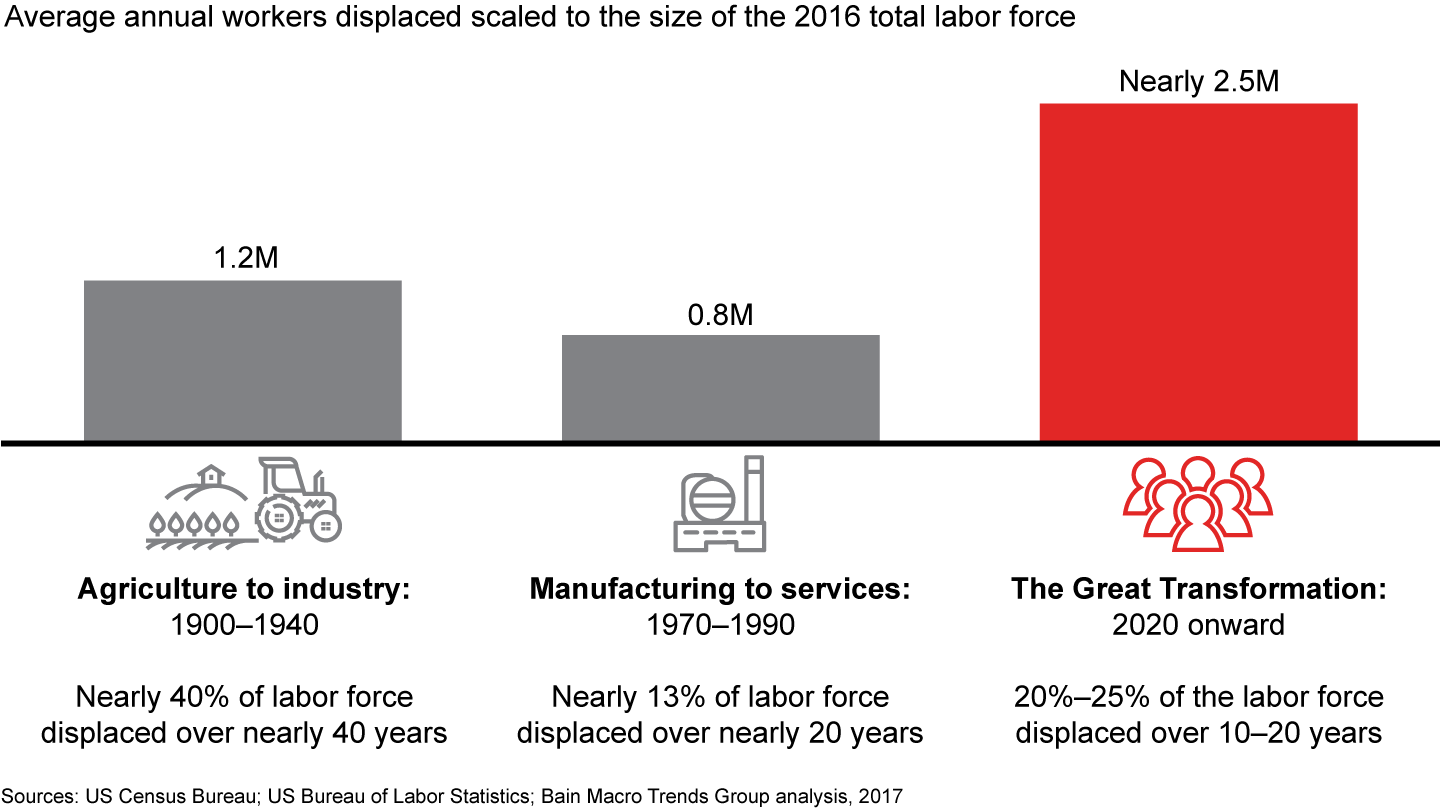
A good job, not just any job
The good news is that the economy continues to generate the kind of jobs that offer clear pathways to advancement and economic self-sufficiency. The question is, what should we be doing to ensure that we are adequately preparing the nation’s young people to succeed in them? To explore that question, Bain launched research to develop a clear definition of what constitutes a good job in today’s economy, identifying where these jobs exist across the nation and assessing what it takes to land one. Building on work from MIT professor Zeynep Ton, the Good Jobs Institute and The Good Jobs Project (run by The Georgetown Center and JPMorgan Chase), Bain defined good jobs using two criteria: First, they should be attractive, offering economic self-sufficiency and stability, including limited vulnerability to automation; second, they should be accessible, meaning they require an efficient investment in training or education (see Figure 2.2).
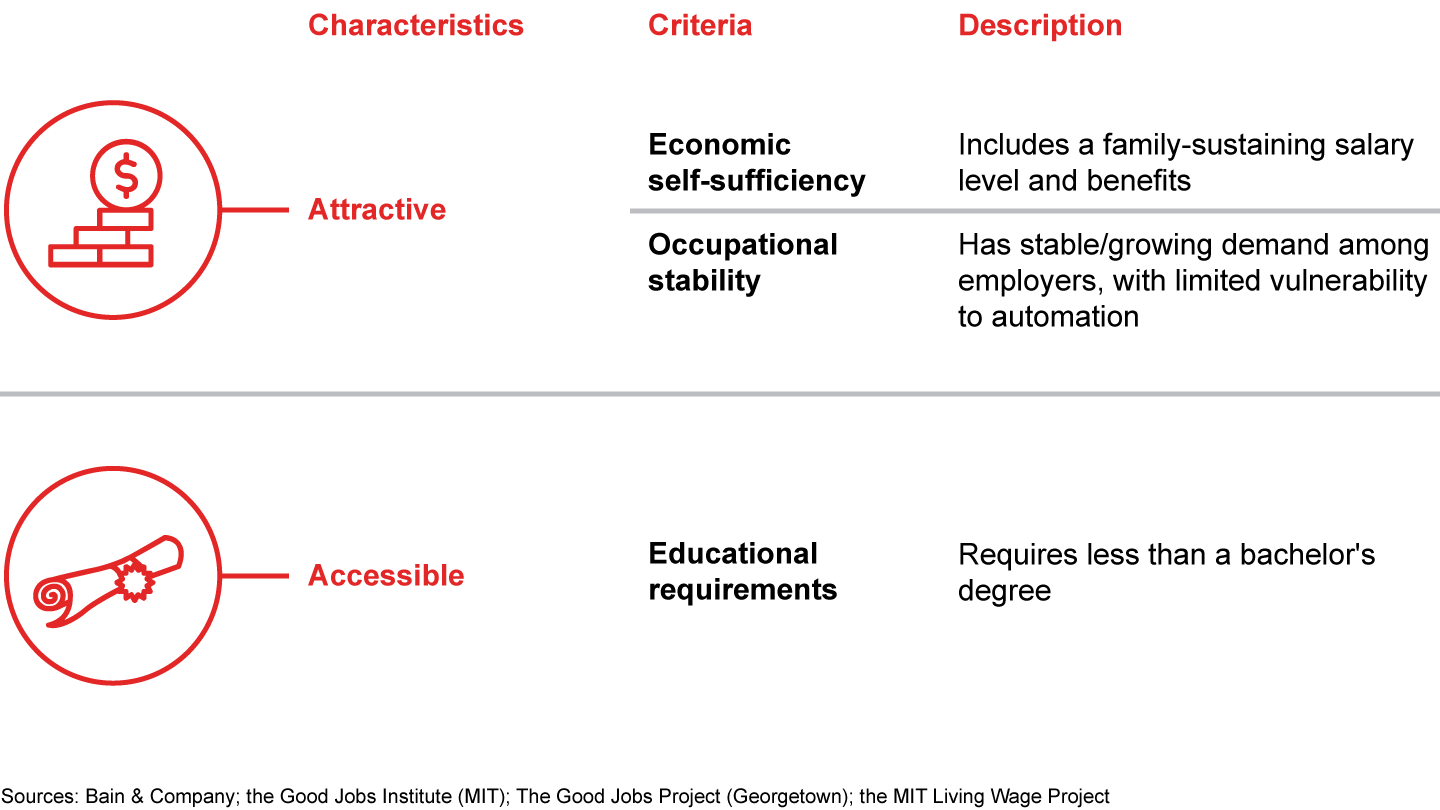
Working with data from Burning Glass Technologies, which tracks real-time job postings, Bain analyzed how many good jobs are available. We also wanted to know where they are in terms of both geography and industry and what type of skills and education they require. Out of 22 million job postings in 2017, we found that roughly half were attractive, and two-thirds of those, or 7.4 million job postings, were accessible, meeting our definition of a good job (see Figure 2.3). Notably, unlike the national labor market statistics, this analysis provides a direct look at employer demand. These are real postings for real positions, reflecting the kind of talent companies are looking for across specific occupations and industries.
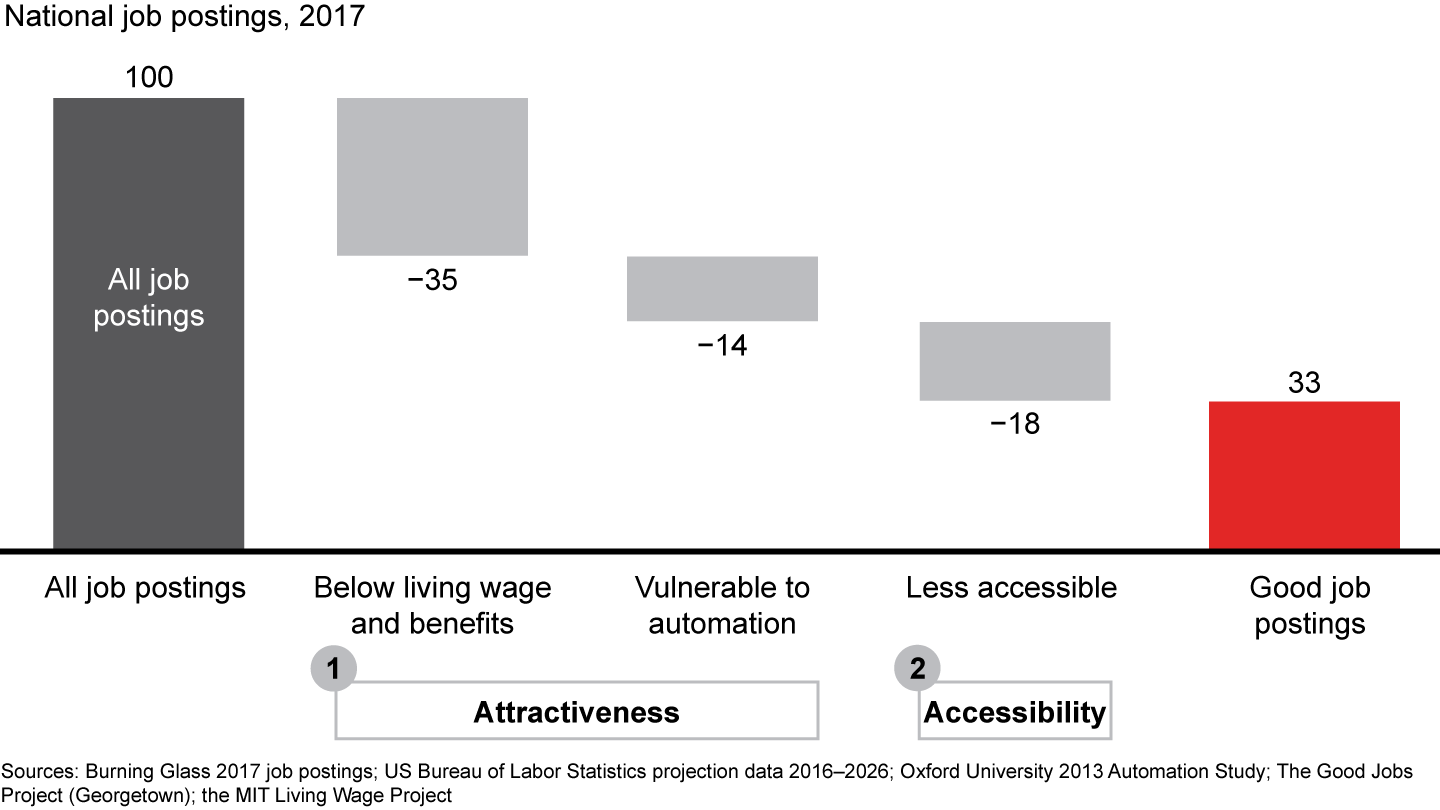
Our research showed that most of these jobs require some postsecondary training or education but that a four-year degree is not necessarily essential. Approximately half of all advertised good jobs required less than a bachelor’s degree, while the remainder had a soft requirement for a four-year degree (see Figure 2.4). By “soft,” we mean that some of these postings had a bachelor’s degree requirement but that other very similar postings did not. This indicates that many employers are asking for a college degree as a screening mechanism, even if the jobs themselves don’t really require the skills or knowledge developed in a specific undergraduate degree. These findings run counter to the conventional wisdom that a college degree is becoming more and more important to attain good jobs.
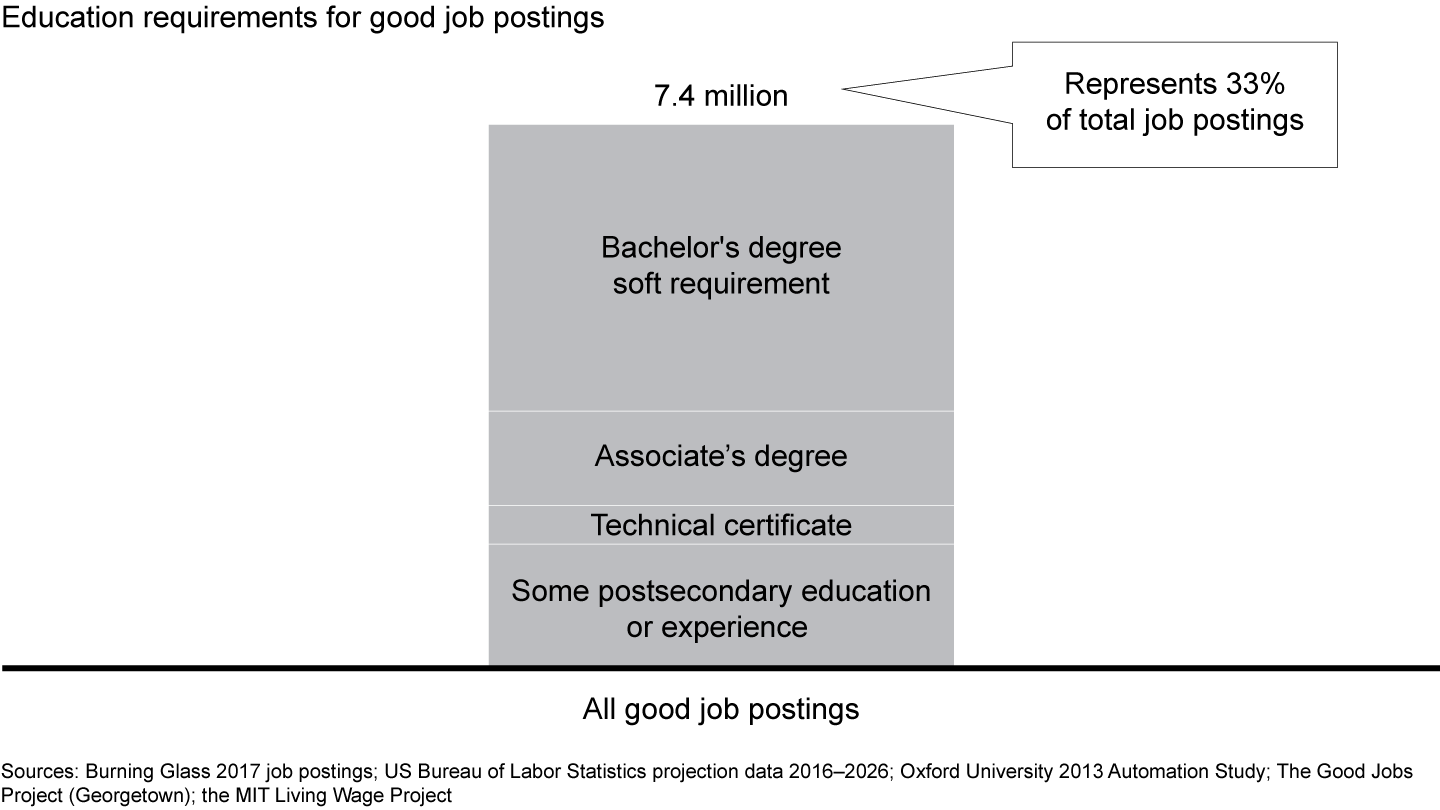
We set a minimum threshold for salary based on a living wage for a family of three in the state where the job was posted. But we found that the majority of postings far exceeded the national living wage of $40,000 a year. More than 50% of good job postings, in fact, had a salary of $74,000 or higher (see Figure 2.5).
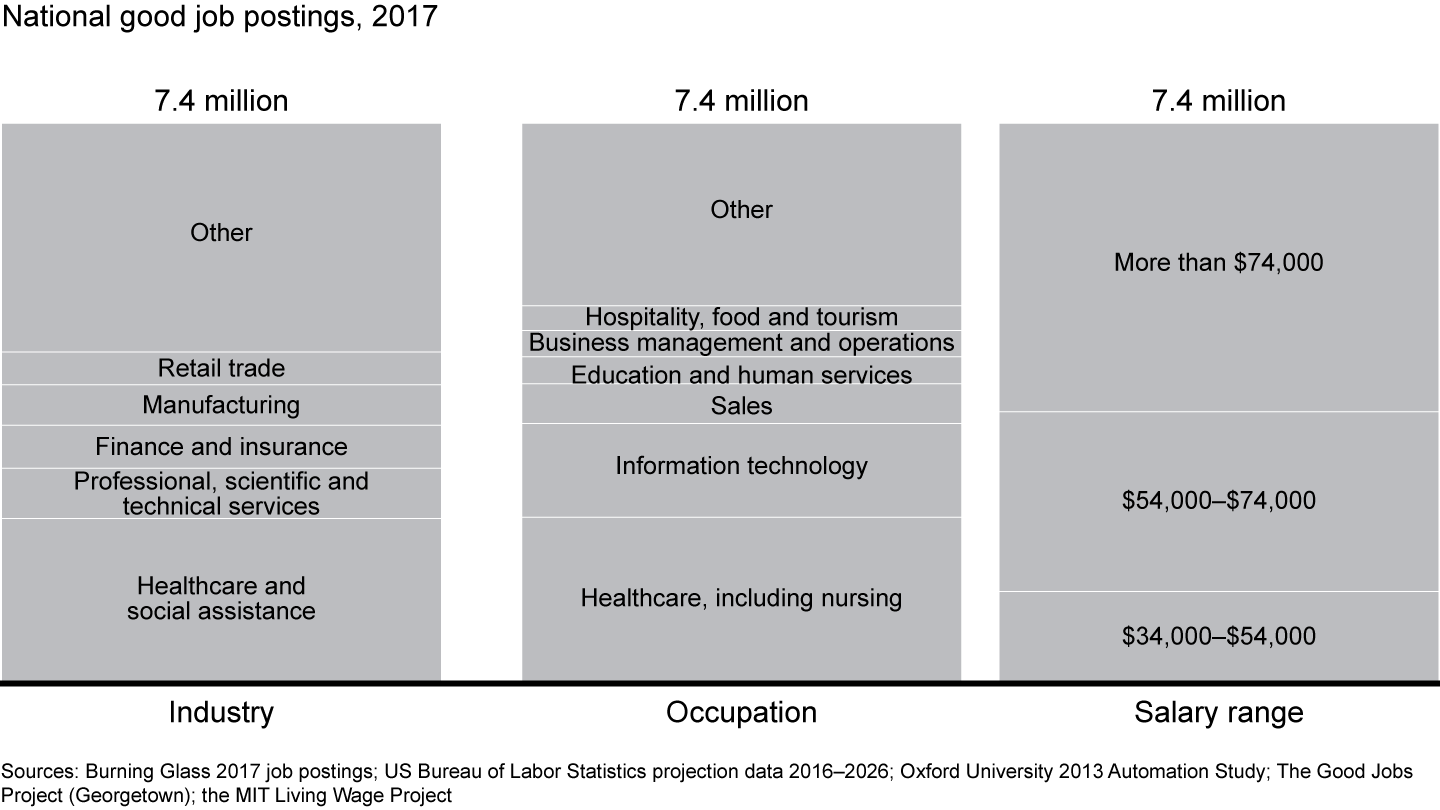
Where are these good jobs being created? Our research demonstrates that they are plentiful and widely distributed across the US. While they are spread out among a diverse array of sectors, roughly half of all job postings are from four key industries: healthcare (representing around 30% of all postings), professional services, finance and insurance, and manufacturing. In terms of occupations, the largest category remained healthcare, followed by information technology, sales, education/human services and business management/operations.
A number of attractive subcategories lie within these broad occupational categories. Healthcare, of course, includes nursing jobs, which pay $75,000 a year on average, according to our job postings analysis. While some employers require a bachelor of science in nursing degree, many nursing jobs are accessible via an associate’s degree. Nurses are in high demand, gain fulfillment from serving others and work in a variety of settings, including hospitals, clinics and the home. They also have ample opportunities for career progression and further education. The same is true of information technology, one of the nation’s most dynamic and fast-growing sectors. It includes jobs such as systems analyst or software engineer, which offer average annual salaries of $92,000 and $107,000, respectively, the analysis shows. While many employers require bachelor’s degrees for these IT postings, more than half do not. Sales opportunities, meanwhile, exist across industries, offering salaries of $85,000 a year, on average, and the opportunity to develop skills that are widely applicable and transferable to other career paths.
We found that every state has a full offering of good jobs. For the majority of states, good jobs ranged between 30% and 36% of all postings. To get a better handle on regional differences, we drilled down on five states of varying populations across the nation: Washington, Florida, South Dakota, California and New York. We found that certain high-demand sectors, such as healthcare and information technology, show up prominently in all states. But after that, differences start to emerge. South Dakota, for example, has more retail and manufacturing jobs, while employers in New York focus more on finding people to fill positions in finance and insurance (see Figure 2.6).
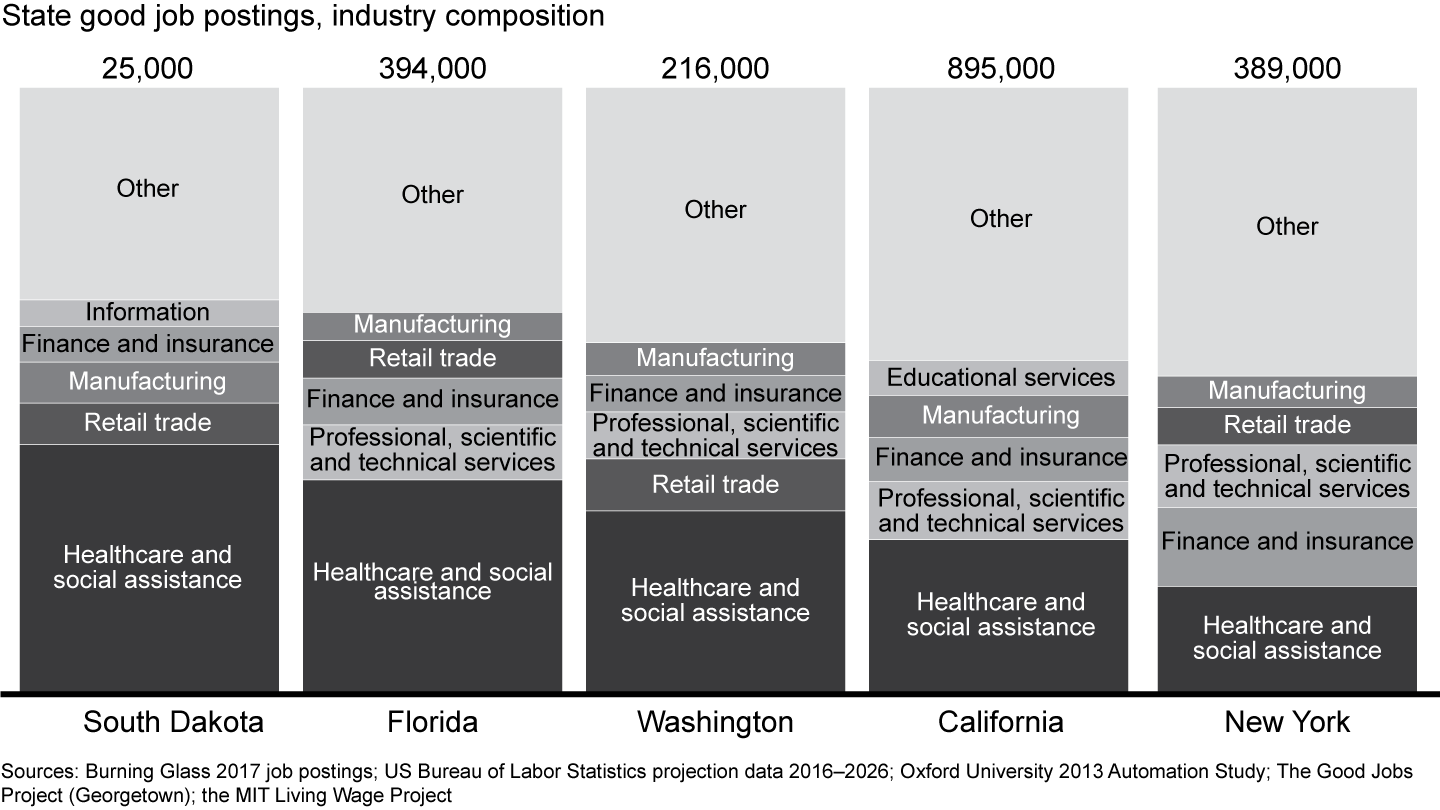
The preparation gap
At a time when the skyrocketing cost of a college education serves as a gating factor for many young people looking to transition to the working world, this large and diverse pool of available jobs should offer an attractive and affordable place to start. Jobs such as these, on their own, offer economic self-sufficiency, but they also offer clear pathways to both professional and academic advancement. The problem is that our educational systems are not adequately preparing young people to take them on. While many students pursue postsecondary education, too few complete it, and fewer still develop the skills to succeed in good jobs.
The transition out of high school is not only a rite of passage but also a particularly critical juncture along the path to gainful employment and a career. Yet for a substantial majority of US young people, the educational journey is curtailed, which can be crippling since 80% of attractive job postings seek candidates with an associate’s degree or higher. According to the US Department of Education, only 42% of high school sophomores go on to earn a two-year or four-year college degree (see Figure 2.7). Even many of those who do enroll in college fail to finish within eight years (see Figure 2.8). For low-income students, the situation is even worse: Just 15% of these young people go on to complete a bachelor’s degree eight years out of high school (see Figure 2.9). In fact, low-income students underperform at every step of the journey. They graduate from high school at a lower rate than average, enroll in college at a lower rate than average and drop out at a higher rate than average.
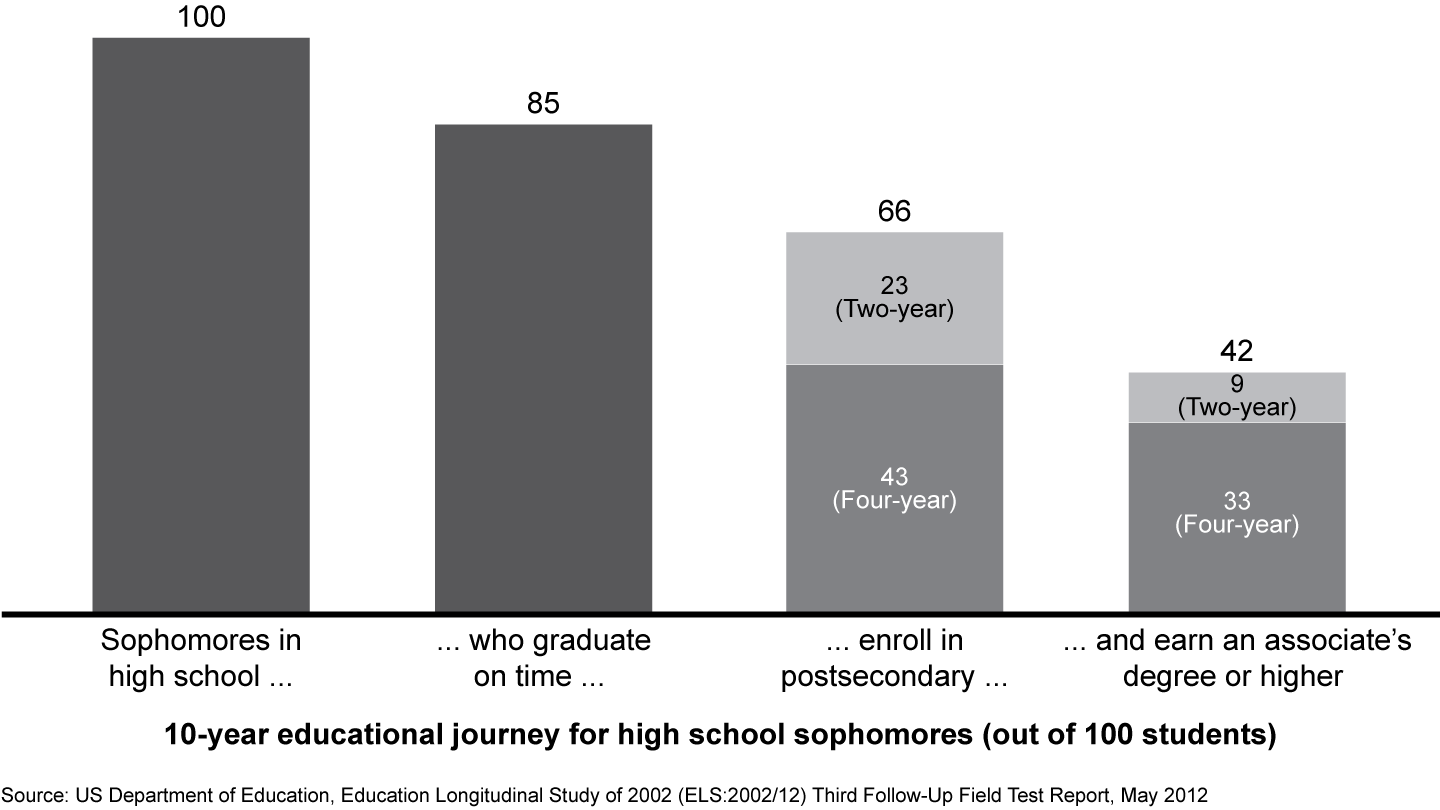
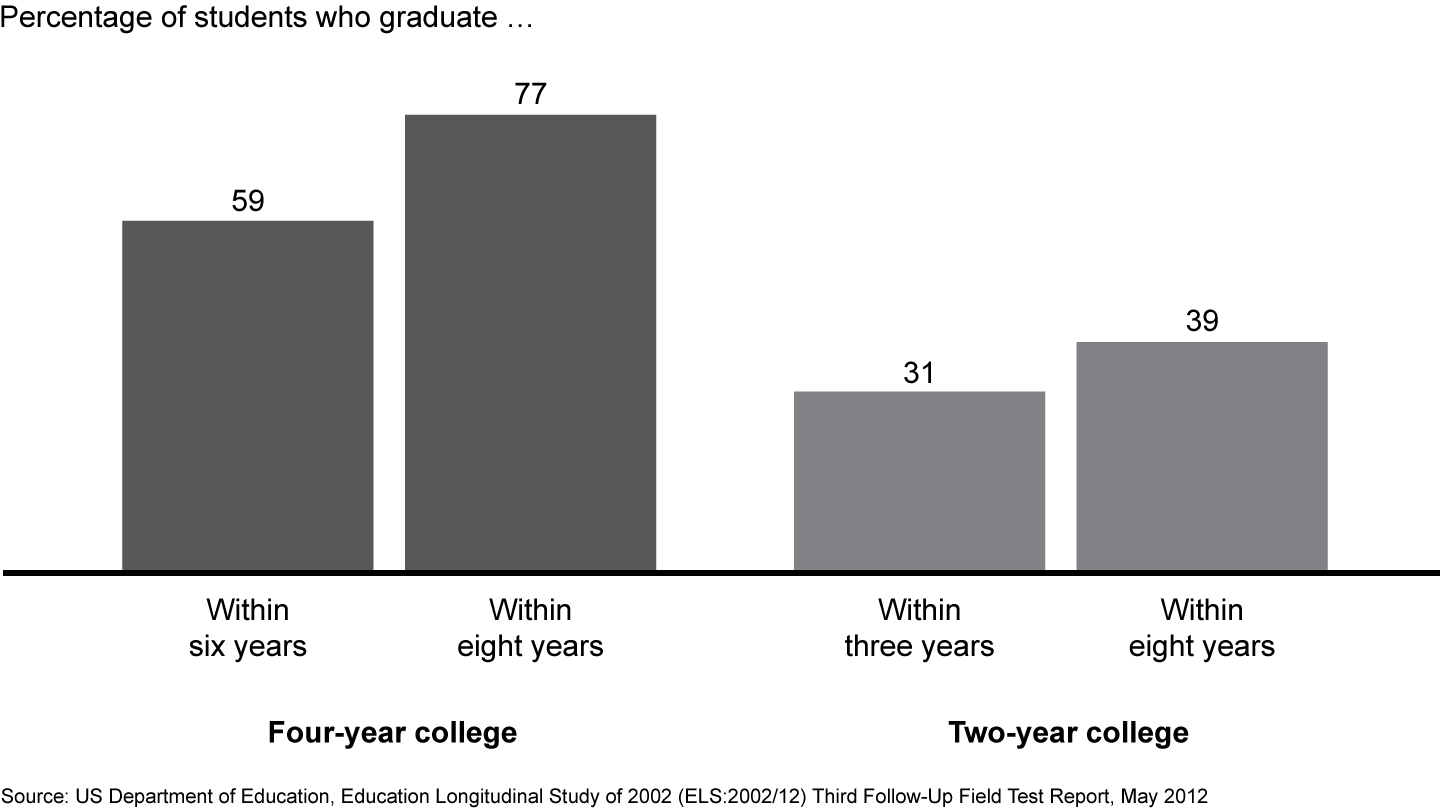
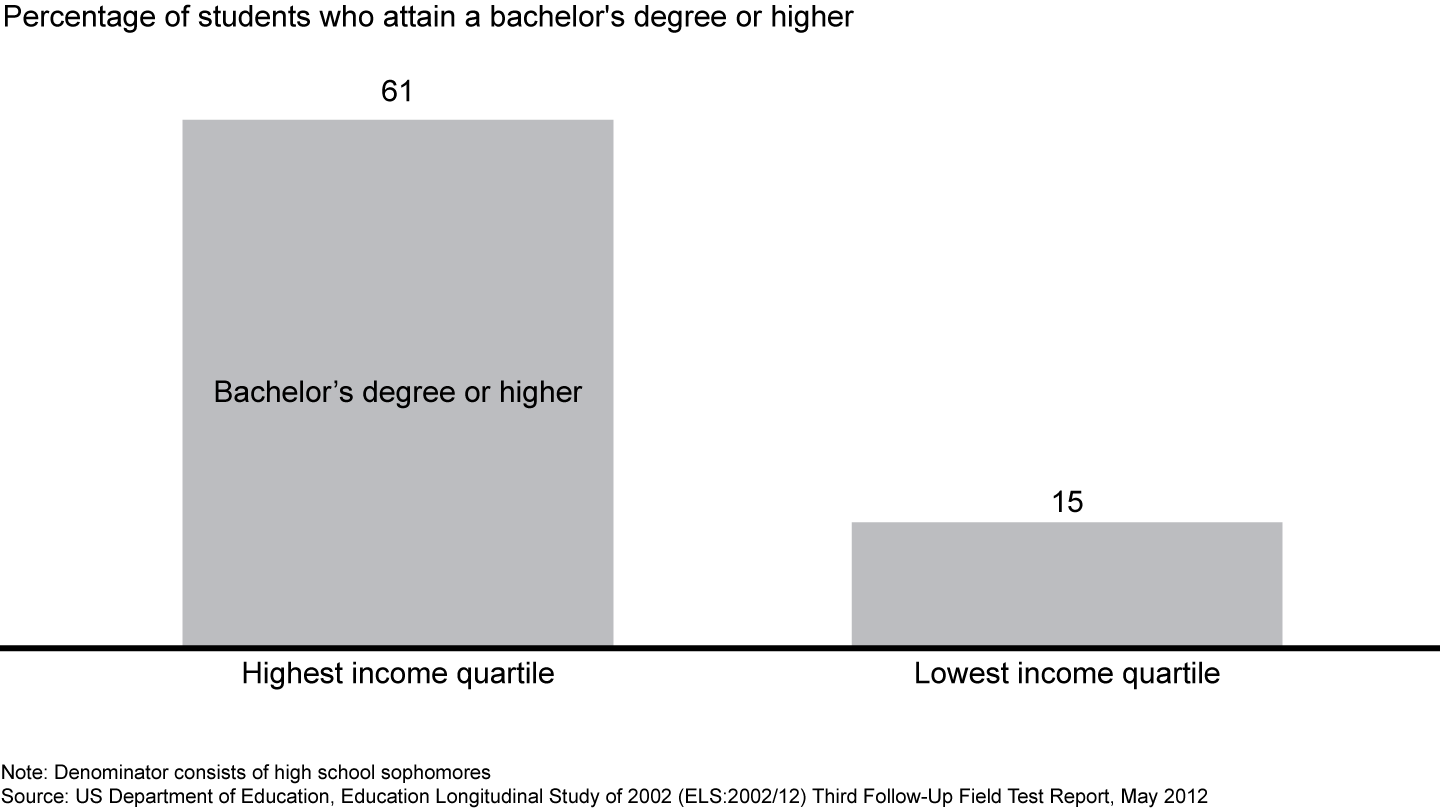
One reason for low graduation rates is that college is increasingly unaffordable for many students. It ends up saddling too many of those who do matriculate with significant debt that puts them in a financial hole before they even begin their careers. Tuition for the nation’s universities has increased dramatically over the past 20 years, while wage growth has significantly lagged (see Figure 2.10). Meanwhile, the volume of student debt in the US has ballooned over the past decade to a total of $1.5 trillion. This dynamic means that students who borrow to finance their education will find it challenging to pay back their loans. And many borrowers simply call it quits before they graduate; the average college dropout has $7,000 in debt.
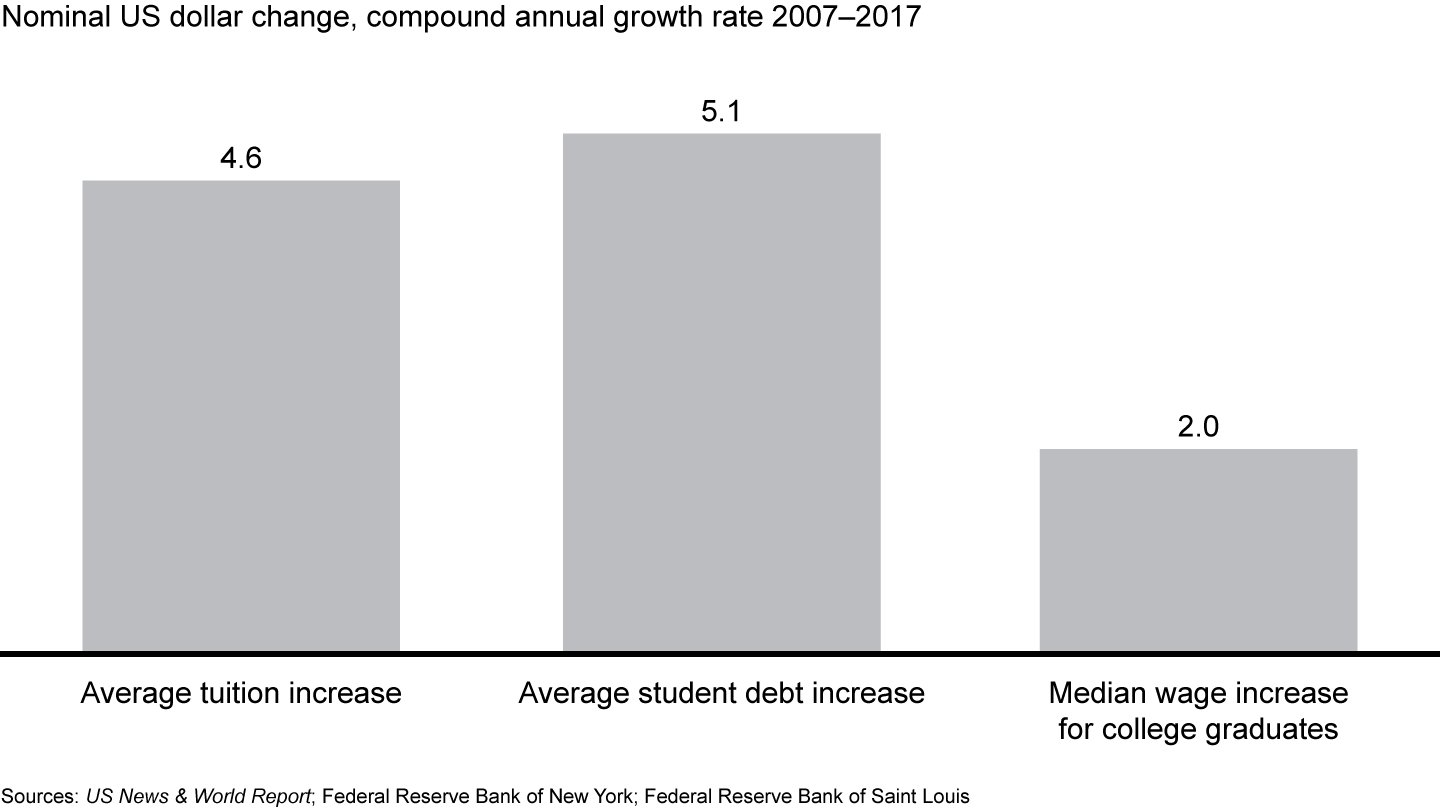
Even those students who do complete college may not be prepared for the workplace. A study by the National Association of Colleges and Employers looked at student and employer perceptions of recent graduate proficiency in a set of competencies critical to launching a career. In many of them—including professionalism and work ethic, oral and written communication, and critical thinking and problem solving—the students overwhelmingly felt they were proficient, while employers did not (see Figure 2.11).
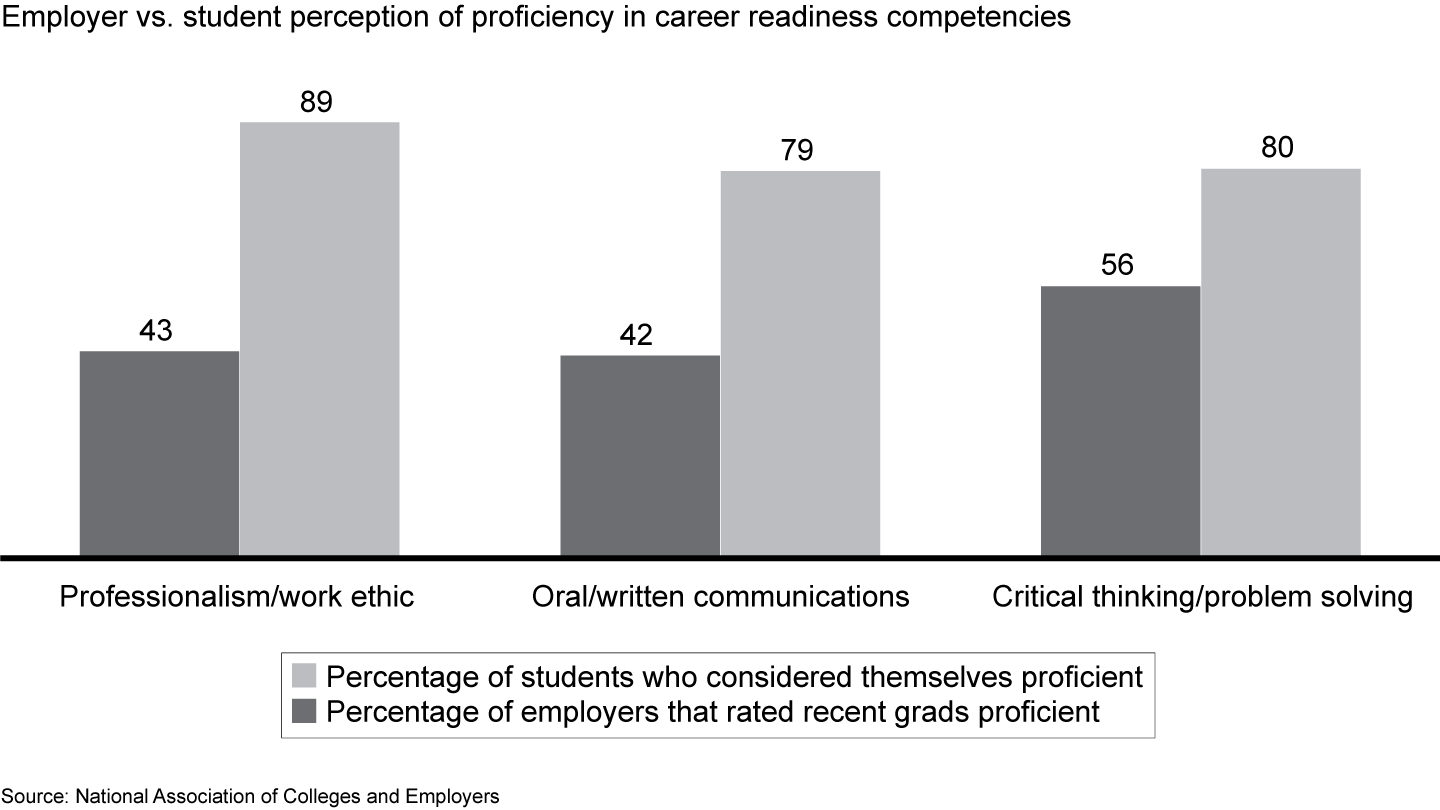
Lack of preparation also extends to technical learning. Despite the strong demand in today’s workplace for science, technology, engineering and math (STEM) skills, only 18% of earned bachelor’s degrees are STEM focused. This lack of preparation is compounded for low-income students, who are less likely to have access to additive work experience while in school to help them develop skills and prepare for landing a good job. High-quality paid internships can provide invaluable on-the-job training and boost a student’s starting salary for a full-time job after graduation. But low-income students often lack the networking connections needed to access these paid positions, and they can’t afford unpaid internships.
The net result of these failures is that youth unemployment is significantly worse than it is for the population overall. Even in a red-hot labor market, a significant portion of young people in the US are without a job or underemployed. By mid-2018, the US youth unemployment rate of 9.2% for 16- to 24-year-olds was more than double the overall unemployment rate of 3.9% (see Figure 2.12). Moreover, approximately 40% of recent college graduates are underemployed, often in low-paying jobs that do not require a college degree, according to a New York Federal Reserve study on the labor market for recent college graduates.
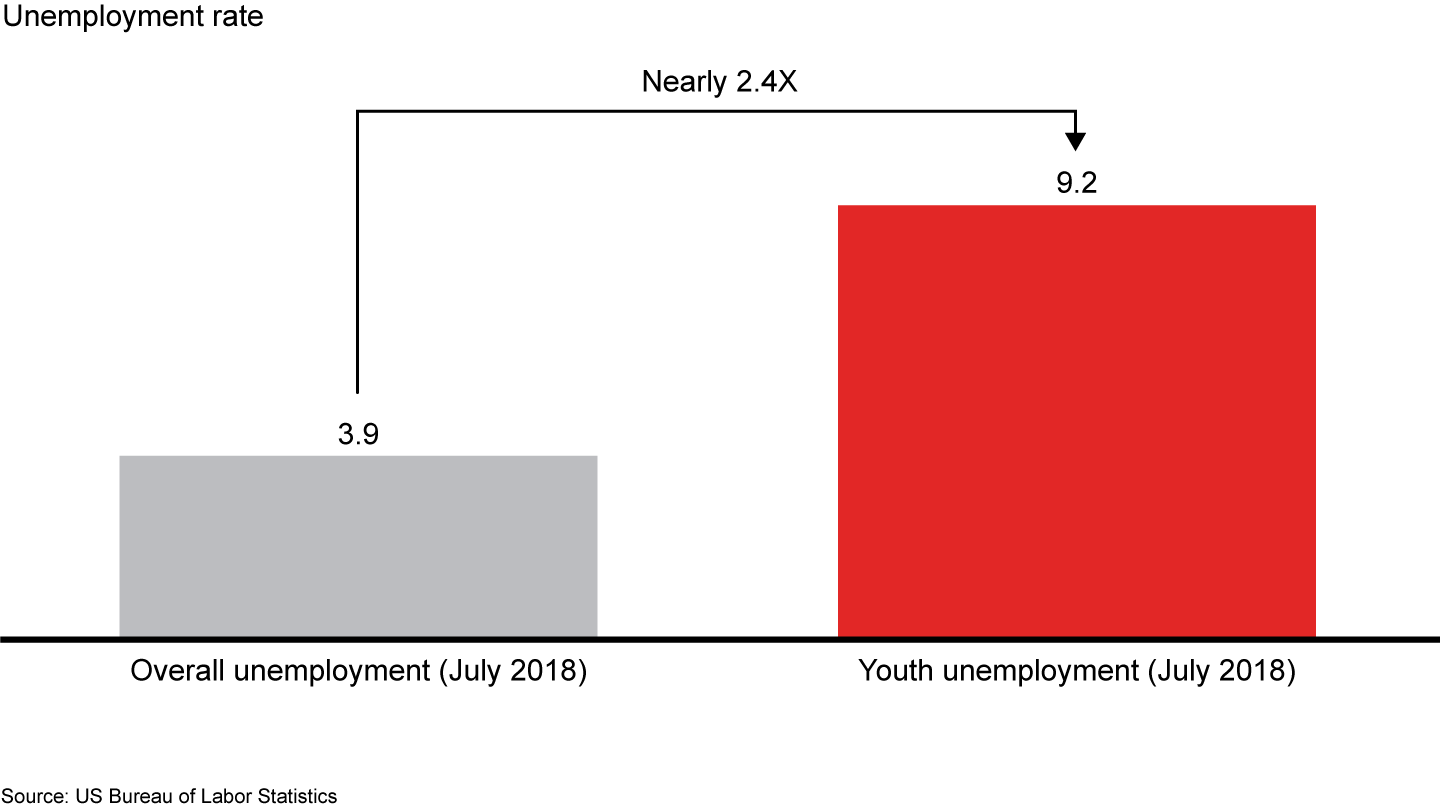
This mismatch between jobs available and qualified candidates is a substantial weak spot in the economy. Not only does it cause pain for the nation’s youth, especially low-income youth, but it also amounts to a significant drag for employers struggling to fill critical positions. Some of this struggle is attributable to the full employment situation. But according to a 2018 study conducted by the ManpowerGroup, there are other structural factors. Of the employers surveyed, 46% indicated they are having difficulty filling jobs for a variety of reasons, including lack of applicants, lack of experience, and lack of both hard and soft skills (see Figure 2.13). For new types of careers—data scientists, for instance—there aren’t enough training or educational programs available to produce the needed number of candidates. Employers also struggle to find candidates for the good jobs that turned up in our research. On average, these positions took 42 days to fill (see Figure 2.14).
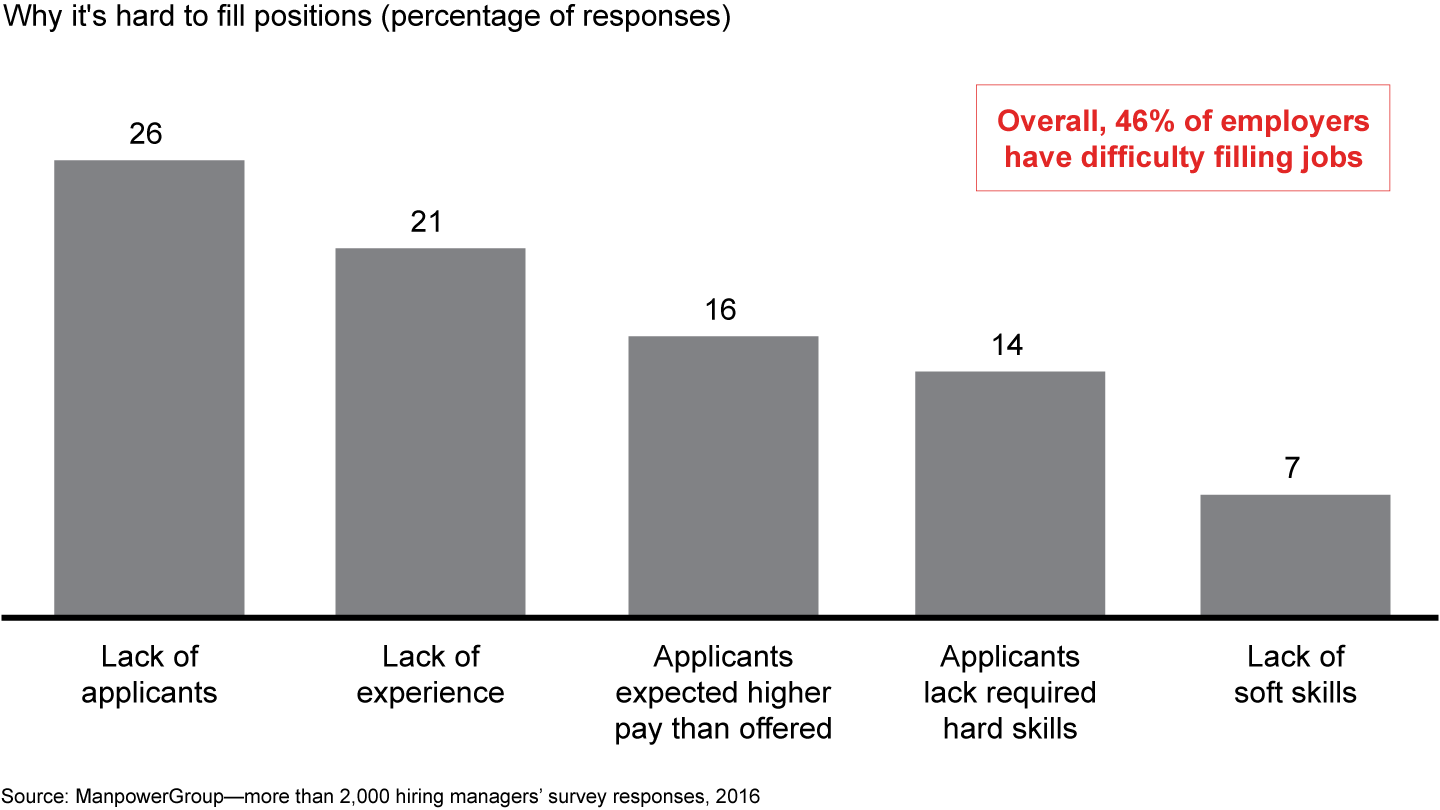
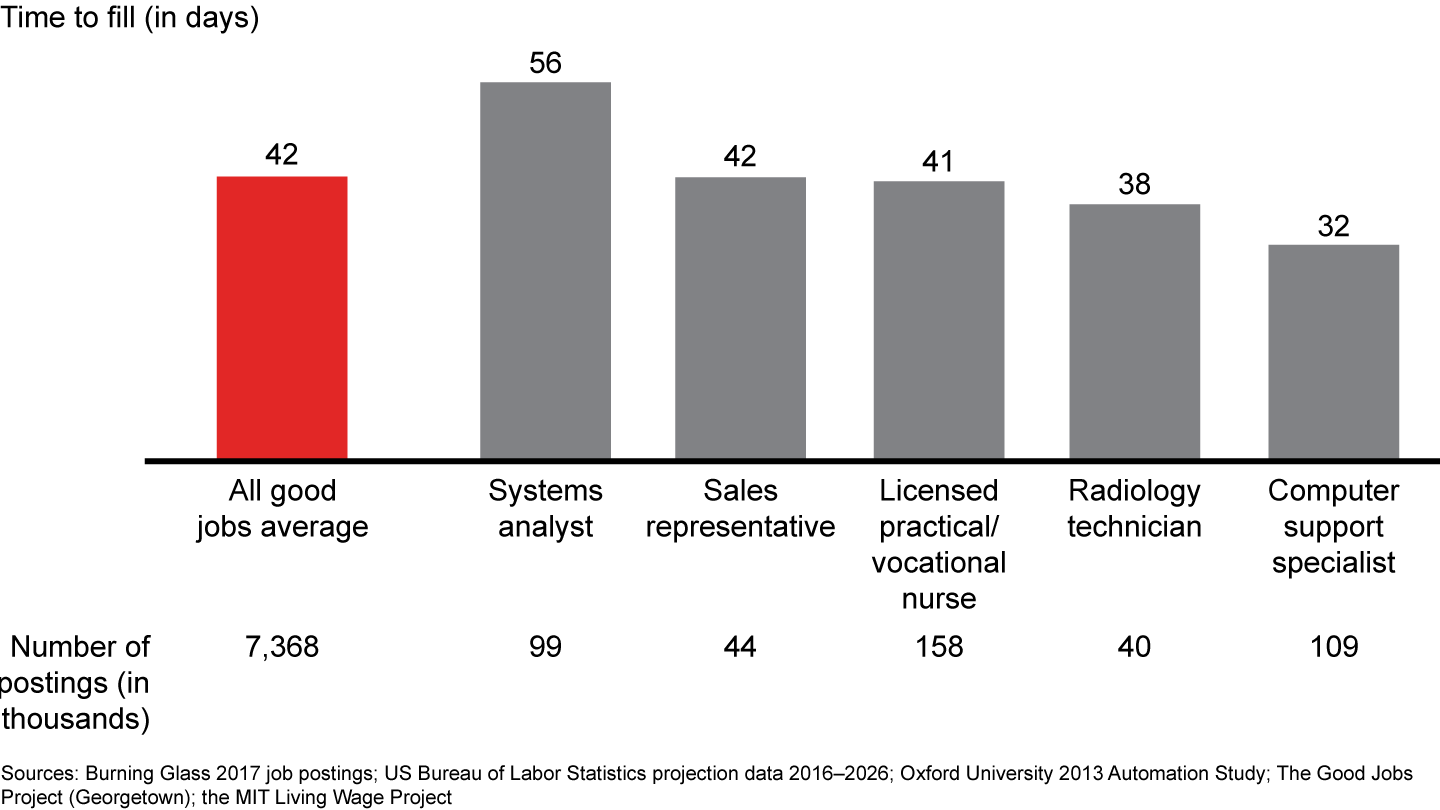
Connecting more young people with good jobs and bright futures will require creative solutions that extend beyond simply doing a better job at what we do today—namely, attempting (and mostly failing) to send all our students to and through college. We generally think of education and employment as sequential steps with education ending before work begins. But given the dynamism of the economy and the job market, that approach isn’t working for too many students. Additionally, this rigid framing causes us to miss out on the opportunity to connect classroom learning with hands-on work experience, which makes learning more relevant, meaningful and accessible for many. Going forward, our students will need affordable, practical ways to learn and work in continual self-reinforcing cycles throughout a career, developing new skills as required to meet the demands of an ever-shifting economic landscape. The question is, what would an effective CCL journey look like, and how can we build the appropriate systems and infrastructure to deliver it at scale?
3. A new model for career-connected learning
A quick look at the jobs data in the previous chapter might suggest that the best path forward is to push more kids through college to get a four-year degree. After all, a college degree is a universally accepted badge of success for young people, and the time spent getting one is widely viewed as the best prerequisite for building a great career. Educators work tirelessly to get students ready for college. But building connections with local employers and creating vocational programs for those students who aren’t on the college track is most often a secondary priority. Federal education spending reflects that prioritization—only 1.8% of the $68 billion budget is spent on workforce development. The assumption all too often is that while we may need to build alternative skills-based programs for students who “can’t cut it,” we should focus the bulk of our attention and resources on those who are aiming to pursue a study-then-work path via a four-year college.
The problem with this logic is that our near-singular focus on encouraging as many kids as possible to attend a four-year institution isn’t working. As we’ve seen, the majority of kids who enter high school don’t end up graduating from college—many because they can’t afford it or can’t rationalize the investment. Even those who do graduate aren’t necessarily prepared for the jobs available, given that many postsecondary institutions aren’t focused on market requirements or haven’t successfully kept up with our rapidly transforming economy. This is by no means to say that attaining a four-year college degree isn’t the right path for many young people. But it shouldn’t be the only one. Pushing all kids to and through college at the expense of other options only threatens to widen the gap between the good jobs available and the capabilities of our young people seeking to access them.
Career-connected learning replaces this “A track/B track” approach with programs that create multiple paths to success by offering open-ended options that allow young people to build toward a career as they see fit. Students can choose the path that best suits their skills, interests and learning style, understanding that one path is not necessarily better than another and that the balance of work and education may shift as paths diverge and reconnect over time. “‘College bound vs. not’ is an old way of looking at the world,” says Maud Daudon, the executive leader of Career Connect Washington, the organization charged with designing the CCL system in Washington state. “This is really about how you learn. Some students learn best in the classroom. Many students learn better when they have a real hands-on opportunity for exploration.”
New paths to success
By creating choice and flexibility, the most effective CCL programs open viable career pathways for far more students. What does most effective look like? Based on our three years of hands-on experience working in Washington, Colorado and other states, as well as extensive research into CCL programs globally, we’ve been able to codify what the best programs have in common. At the highest level, they are market driven and student centered, a concept we will explore in depth in a moment. But an essential starting point for career-connected learning is the understanding that it is a connected series of experiences that come in three phases, beginning with awareness, building to preparation and culminating with career launch (see Figure 3.1).
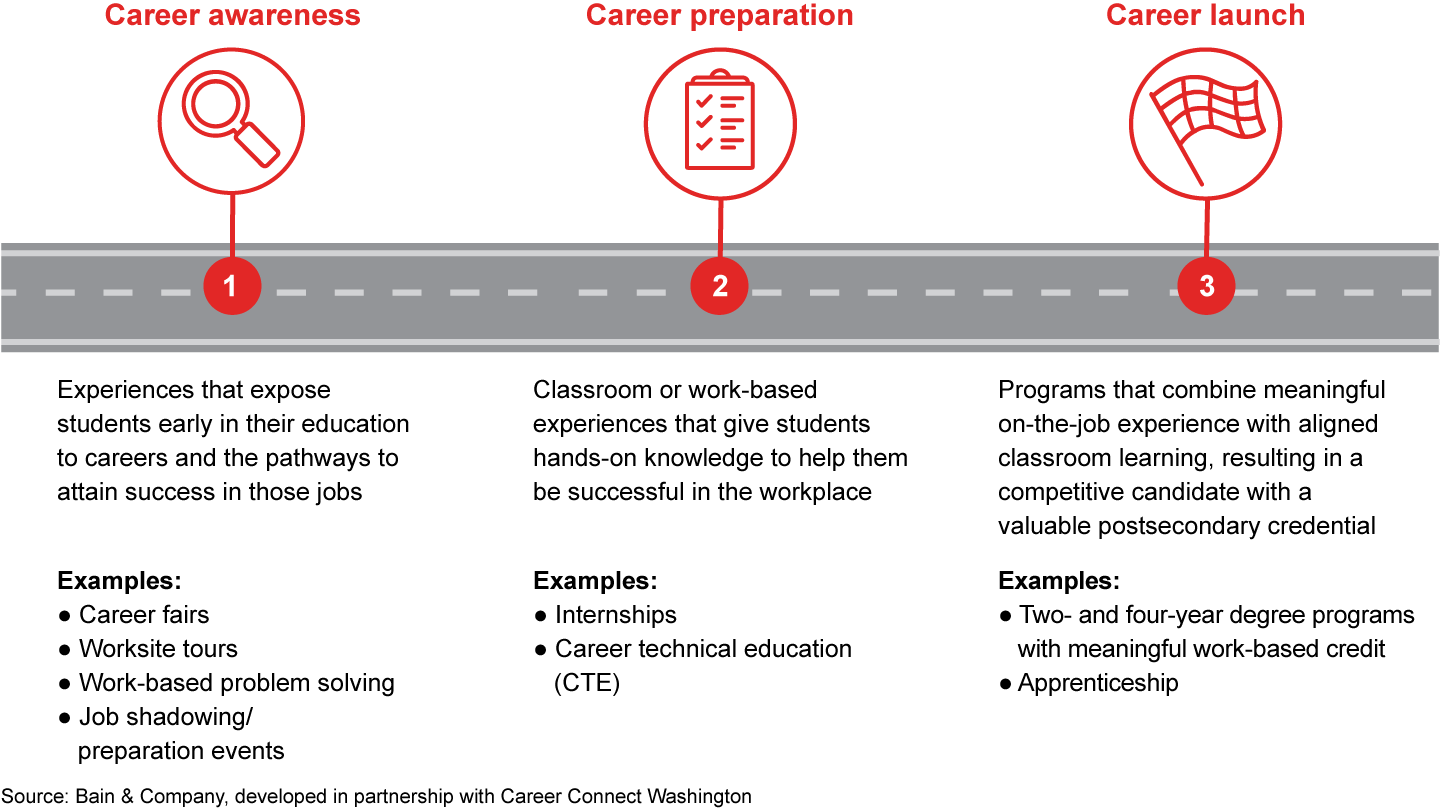
Few places in the US are set up to deliver this phased approach at scale. But, as we discussed earlier, several are in the early stages of building such a statewide system, and highly successful working models exist around the world. To illustrate how a strong, end-to-end program might work in the US, let’s walk through an example of a hypothetical teenager named Camila drawn from a composite of the best practices we’ve observed in the field (see Figure 3.2).
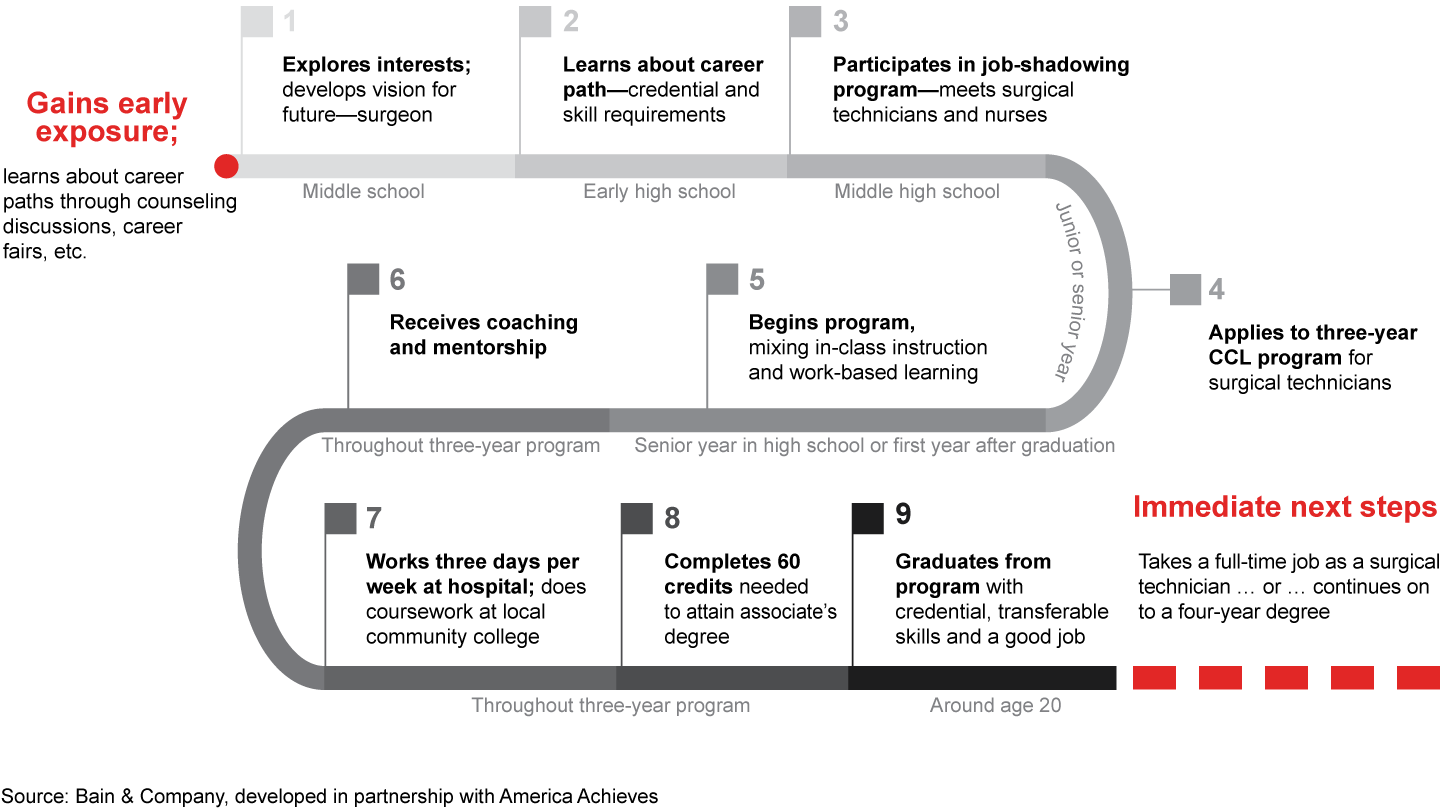
Camila first encounters career-connected learning as a middle school student. She’s a bright kid who enjoys school but doesn’t typically excel on tests. Similar to many people her age, she hasn’t given her future much serious thought, but as part of a CCL program, her school offers job fairs and guest speakers that expose her to a variety of possible careers and what it might take to succeed in them. These sessions light a spark in Camila, and she starts imagining herself getting involved in healthcare, maybe even becoming a surgeon. Through subsequent conversations with a school guidance counselor, she starts to see what skills and credentials she would need and how she might acquire them.
During the summer before her junior year, Camila participates in a job-shadowing program at a local CCL-affiliated medical center. She spends time in a hospital, shadowing people in multiple roles from surgeon to nurse to radiology technician to surgical technician. She begins to recognize that she might not be ready financially or academically to pursue a four-year degree followed by medical school. But she loves the hospital work and hears about a three-year CCL pathway to become a surgical technician—a job that could be a springboard to a number of careers in healthcare. She applies and gets in.
The program begins in high school and continues after graduation at the local community college. Camila works part time at a local hospital two to three days a week and takes classes both at her high school and at a local college. In her classes, she learns anatomy and physiology, medical terminology, microbiology and patient care. As part of an associate’s degree, the classes also fulfill general education and science requirements. At the hospital, under the supervision of a mentor, she learns how to set up surgical tables and anticipate the needs of surgeons during a procedure. She monitors patient conditions and surgical team progress, keeping accurate written records. Throughout the program, Camila connects with a counselor who checks in regularly to ensure she’s on track. The counselor helps her troubleshoot issues, coaches her on how to succeed in a professional workplace and helps her access resources, such as academic help, pathway counseling or assistance with transportation to and from work.
At the end of three years, Camila has earned an associate’s degree in surgical technology, with up to 60 transferable semester credit hours, and she’s prepared to take the national surgical technician certification exam—all paid for by the CCL program. She also has three years of paid work experience, is debt free and has a good chance of continuing work for the hospital that sponsored her career launch experience. Now Camila has a choice. She can enter the workforce full time as a surgical technician, making around $46,000 annually, with a steady schedule, benefits and the satisfaction of being an integral part of a surgical team. Or she could continue her education, applying her credits toward a four-year bachelor’s degree in health sciences, which could lead to a variety of careers in medicine, public health or administration but could also be a prelude to medical school. Either way, at age 20, Camila is in charge and has a significant head start on developing a highly fulfilling, sustainable career.
Elements of this scenario are happening in CCL programs all over the US—inspirational examples of forward-thinking employers and educational institutions forging connections to get an innovative effort up and running. But replicating programs such as these to serve far more students will require some significant changes to the status quo. We need more educators in middle schools and high schools with a thorough understanding of career pathways. We need high schools and colleges with flexible schedules to accommodate work and learning. We need rigorous and high-quality career launch programs with stackable and transferable credits that allow students to apply work-based learning toward future degrees. We need employers who are willing to invest in prospective employees.
To build momentum, we need a mindset shift. Educators need to embrace the idea that a student who pursues a study-and-work path with her eyes set on both a good job and a degree is not on a less important path than a student who is pursuing a study-then-work path straight into a four-year academic-only program. This is a big shift. As one educator told us, “I haven’t dedicated my life to delivering employees to employers; I serve students.” What that attitude assumes is that all students are best served by the same approach to education and career development, which we know to be untrue. Some learn best through hands-on experience. Some find motivation to succeed academically by seeing firsthand how their knowledge applies to the workplace. Some can’t afford the academic-only route but could thrive in a study-and-work approach. Many already spend a great deal of time working, but at low-wage, low-skill jobs that do not advance their career prospects. At the moment, too many of these students are being left behind. Career-connected learning can give them the agency and inspire them to succeed both academically and in launching themselves into careers.
Market driven, student centered
CCL programs with the most impact and staying power deliver on this promise by addressing real needs in the communities they serve. They are designed around the idea that the program has to be both market driven and student centered, meaning it has to make sense for both students and employers so that both sides will invest with purpose for their mutual benefit (see Figure 3.3). Let’s break down what that means in practice.
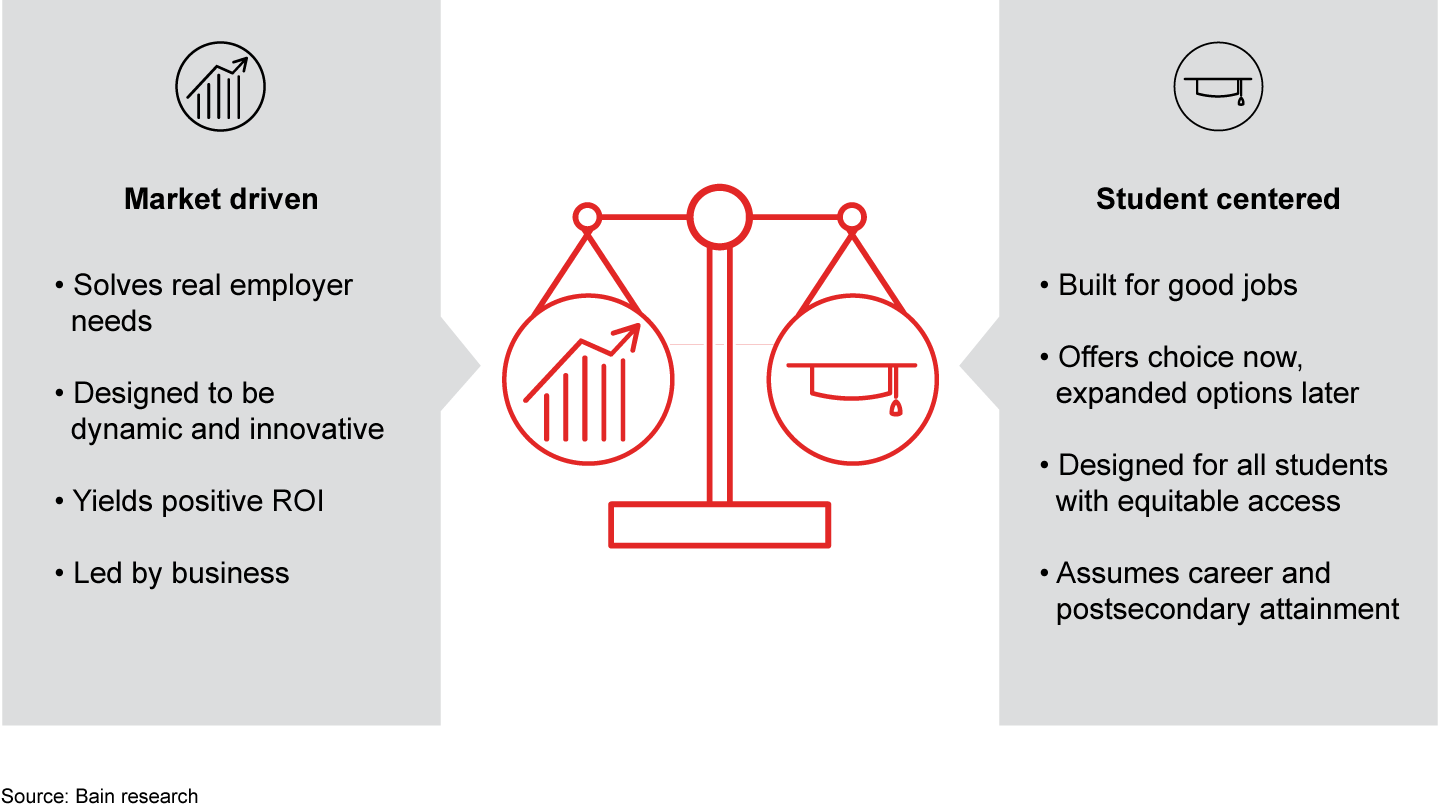
Market driven—real solutions
For career-connected learning to make sense to employers, it has to help them access the talent and capabilities they need to run their businesses. This isn’t a form of corporate philanthropy; it’s a way for employers to develop a much larger pool of local talent trained in the skills and competencies required to address critical and ever-changing business needs. As we noted in chapter 2, companies around the US struggle to fill good jobs because there aren’t enough well-trained candidates. Investing in career-connected learning at scale is a proactive way to encourage a stable flow of talent, often from local communities that are currently underrepresented in a company’s workforce.
One IT executive actively involved in the formation of Washington state’s nascent CCL system said that the company’s interest stems from a vital need for technical talent. “We simply cannot meet the demand we have for tech skills in the open market right now,” he said. Another IT executive echoed that concern: “The appetite in the marketplace for tenured talent with five to seven years of experience is insatiable. Today, it’s a huge problem. But if we don’t get enough entry-level talent in the pipeline now, then the problem is only going to be exacerbated in the future.”
Phil Kalin, the CEO of Pinnacol Assurance in Denver, is certainly civic minded, as evidenced by the company’s commitment to award $5 million in college scholarships to 500 students since 2000. But the reason Pinnacol was one of the first employers to commit to Colorado’s CareerWise youth apprenticeship program was because Kalin’s company needs to increase the flow of younger workers into its pipeline. Pinnacol views the CareerWise program as a way to infuse its aging workforce with younger talent. The idea is to train new actuaries, claims specialists, IT developers and others to cross-pollinate with older employees, who can transfer their institutional knowledge, and keep Pinnacol competitive. Bringing in a cohort of digital natives should also pay dividends in an industry moving rapidly toward automation and digitization.
Market driven—dynamic and innovative
Because coping with disruption is mission critical for any employer in today’s rapidly changing economy, CCL programs also need to be dynamic and innovative, evolving continuously to prepare students with the skills and capabilities that currently are in demand. Among existing programs, there are various approaches to building in dynamism and innovation. Zip Code Wilmington (ZCW), which trains software developers in Delaware, meets the fast-changing needs of that city’s finance sector by setting up an employer advisory board that meets three times a year to review curriculum. ZCW regularly collects feedback from graduates on what else they wish they had learned, and at the request of a specific employer, it can create add-on course modules that graduates complete after the company has hired them but before they start work.
Creating this kind of responsiveness took an intentional effort for Ivy Tech, the forward-thinking community college system in Indiana. Ivy Tech serves 160,000 students with 1,000 online classes and more than 150 programs at 40 locations throughout Indiana. Before 2016, it suffered from lackluster interest among employers and was often unresponsive to changes in the marketplace. That year, Ivy Tech hired Chris Lowery as senior vice president of workforce alignment and set him to work ensuring that the system played a leading and collaborative role in Indiana’s economy. He focused on aligning offerings with employer needs and developed an industry advisory board consisting of a key employer and an industry association representative from each of six key sectors. In addition, at each of its campuses, Ivy Tech has deployed an employer liaison who is responsible for identifying employer needs, targeting high-promise careers and discerning needed skills and competencies for those jobs. By amplifying and prioritizing the voice of employers, Ivy Tech has become much more responsive to the marketplace. While it’s still early in the transformation, Lowery says, “We’ve become increasingly attuned to the outcome side for our economy and our students. We are moving beyond enrollment as the primary measure [of success] to what we produce for our students and our employers—ready talent for high-demand, high-wage jobs.”
Market driven—yields positive return on investment
In addition to solving a tangible business need, a sustainable CCL program ultimately has to generate a positive return on investment (ROI) for employers. Meaningful career launch programs require a significant employer investment in student wages, supervisory and mentor time, tuition reimbursement and internal program management. In return, employers want to be able to see real benefits, both in terms of stronger talent pipelines and measurable value flowing from the work students do as part of the CCL program. Positive ROI during the program is a core component of the Swiss system. The Swiss government closely monitors ROI, studying the results from companies that participate in the program and comparing them with those that don’t. This process helps the system identify best practices, continuously improve and ensure that employers are seeing returns. Importantly, the system has been able to demonstrate that the productive output generated by student learners during their apprenticeships allows Swiss companies to realize a net benefit from their participation (see Figure 3.4).
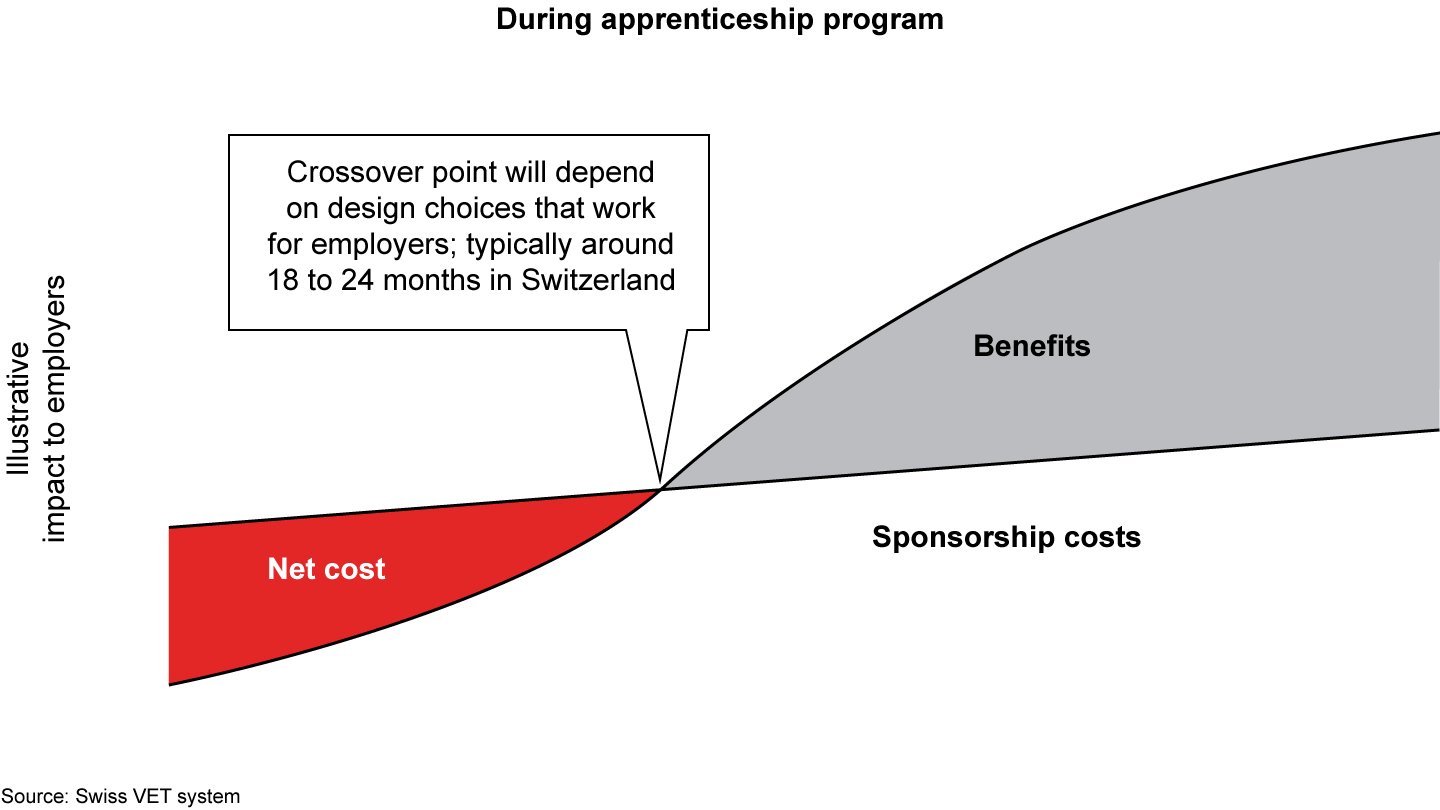
Market driven—business led
The ability to capture real value from career-connected learning is what gives employers the motivation to bring the program to life and help manage it. This kind of leadership on the part of the business community is essential to any program’s growth and sustainability. “Businesses need to become the creators and not just the consumers of tomorrow’s talent,” says Washington state Employment Security Commissioner Suzi LeVine.
Washington state’s system, which is in its infancy, made business led one of its key design principles. If the system wants to meet its bold ambition of creating 60,000 career launch opportunities over the next decade, it will need the full participation and leadership of the state’s major employers. To build buy-in from the business community from the start, Governor Jay Inslee enlisted the help of Maud Daudon, then the executive director of the Seattle Chamber of Commerce, a deeply networked and respected leader in the employer community. He asked her to create a strategic plan, and she, in turn, formed a leadership group representing all major industries and employers such as Microsoft, Amazon, Boeing, Kaiser and Avista to guide the process and weigh in on strategic decisions. Employers brainstormed solutions and broke down barriers. The business-led approach ensured that Washington’s CCL system could count on the deep involvement of the most influential employers in the state.
Student centered—built for good jobs, not just any job
While business commitment and leadership are critical to career-connected learning, it is equally important that programs focus on student interests. Market driven, in other words, has to jibe with the understanding that the intent of career-connected learning is to propel students into economically self-sufficient and fulfilling lives. Not all paths lead there; a dead-end job with low pay and no chance of advancement does not offer the opportunity to build a career. If career-connected learning is to fulfill its promise, all stakeholders have to align around a commitment to generate real opportunity for young people. Career launch opportunities have to set students up for success in good jobs, not just any job (see Figure 3.5). “CareerWise isn’t building apprenticeships for everything but rather for careers with progression and where credentials have value,” says Eric LeVine, a member of CareerWise Colorado's board and Career Connect Washington's Business Leadership Committee.
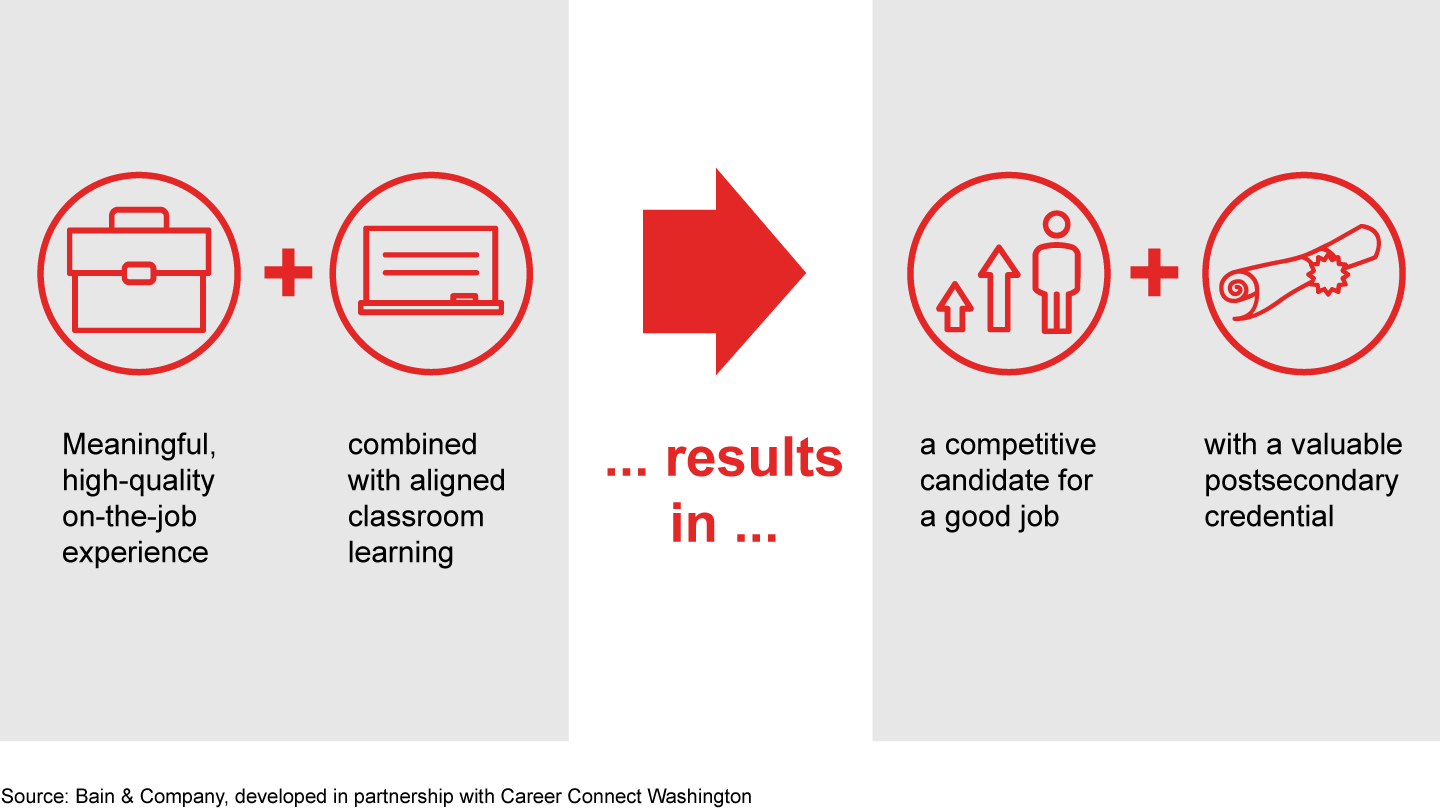
Good jobs, as we defined them in chapter 2, are those that lead to economic self-sufficiency as well as choice-filled lives. The Wisconsin Youth Apprenticeship system has thrived for more than 25 years and grown to statewide scale partly because the state assures that the available jobs within the program meet strict criteria. Amy Phillips, the youth apprenticeship coordinator for the Wisconsin Department of Workforce Development, explained that “when we have an employer or industry indicate that they’re interested in having another pathway added—and assuming we have funding to move forward—we have a protocol to ensure there is true market demand and employer support. We conduct labor market research to ensure the market is projected to grow and ensure the student can earn a living wage in this space.” In addition, Wisconsin is careful not to tailor the apprenticeship to a particular company but to the broader industry, instead. That way, when a student completes an apprenticeship, the skills and credentials he or she earns are portable from one job to another as opportunities present themselves.
Student centered—choice now, expanded options later
Choice and agency are also essential characteristics of a student-centered CCL program. A major criticism of many vocational programs is that they rely on tracking students down particular pathways that lead in only one direction. The most effective CCL programs not only focus on good jobs but they also create options, recognizing that as students grow and evolve, their interests, capabilities and motivations will as well. The ability to make choices is a hallmark of the system in Switzerland. Starting at age 15, 70% of all Swiss students participate in a three-year apprenticeship, choosing among 230 occupations and splitting their time between classroom learning at a vocational school and part-time work at a host company under the guidance of an experienced supervisor. At the completion of the apprenticeship, they have the choice of continuing employment, continuing technical education or going back to an academic-only track. The choices open to them are the same as the 30% of students who chose the study-then-work full academic route in the beginning.
Wisconsin offers a good example of choice in action in the US. The youth apprenticeship system recently launched a biotechnology program (mostly offered in the Madison area). It involves both classroom work and hands-on lab experience at private local employers or at the University of Wisconsin, Madison. One apprentice recently finished the two-year program and had the option of continuing work or furthering her education. She chose to push toward an advanced degree at Columbia University with confidence that her hands-on experience will give her a leg up when it comes time to move back into the working world.
Student centered—designed for all students with equitable access
Offering these opportunities to all students, not just those at the top or the bottom, is essential to building student-centered programs. Ensuring access to everyone requires that programs are financially attainable and that they encourage the participation of students from across the board, regardless of gender, ethnic or racial background, previous educational attainment or learning style. It is not imperative that all programs serve all students, but it is imperative that all students have real, viable choices and the opportunity to be successful.
The best CCL programs invest in the student supports necessary to broaden the opportunity to the widest possible population of students. But for a new program, that can present some challenges. When Colorado’s CareerWise was launching its youth apprenticeships, it wanted to cast the program as a rewarding and desirable pathway to counteract historical concerns that career-connected learning is less valuable or less prestigious than a four-year degree. So it set a high standard: All programs would combine paid on-the-job experience with aligned classroom learning in college-level courses. That argued for loading the first few cohorts of students with those most likely to succeed. But the educators at Denver Public Schools who helped design the system were also committed to building programs for students with the greatest need—namely, those who weren’t the strongest academic performers and likely would be challenged by the college-level coursework.
The answer in Colorado was a hybrid approach. In order to get the flywheel turning and build employer demand, CareerWise and Denver Public Schools designed a program that attracted high-performing students. At the same time, they built in additional supports to serve students who were less ready for college-level work, including intensive counseling support and remediation over the summer. To pay for this level of support, Denver Public Schools is putting philanthropic dollars to work to ensure that students from all backgrounds and all levels of readiness have the support they need to succeed. But over time, program leaders believe that by generating employer buy-in and building scale, the system will ultimately be able to self-fund the kind of support that ensures the success of higher-need students and will expand to offer desirable CCL opportunities that require less academic preparation.
Student centered—assumes career and postsecondary attainment
This last point is a critical one because the highest-impact CCL programs provide opportunity and choice for all students. As we noted earlier in this chapter, the idea of career or vocational programs often evokes a visceral reaction among educators, who recoil at the notion of forcing students to choose between a life of promise attained on the academic highway or a predetermined path to a paycheck with limited to no upside. High-quality CCL programs produce critical thinkers and strong employees. They prepare students for careers and postsecondary attainment. In the best programs, these goals are mutually reinforced, not in opposition. “The biggest hurdle these programs face is if they are seen as ‘less than’ academic-only pathways,” says Washington’s Daudon. “We need to ensure rigor and high quality as we change that narrative.”
While many students go straight from their apprenticeships to employment, many others will use their apprenticeships as a launching pad into higher education, as we saw with the graduate of the biotech pathway in Wisconsin. The CCL path also has benefits an academic-only track can’t offer—for example, aligned work experience, exposure to working with adults and a real-world understanding of career possibilities within a field. SEH America, the company we introduced in chapter 1 that launched a pioneering CCL program in Vancouver, Washington, makes sure that its students get a full range of growth experiences. Ben Bagherpour, the executive who built SEH’s program, said it is intentionally oriented toward both hard skills, such as how to work in a production area, and soft skills, such as communication, teamwork, critical thinking and problem solving. SEH is also committed to sponsoring employees as they work toward their four-year degree.
Career-connected learning such as this can be game changing for both students and employers (see Figure 3.6). The examples we’ve talked about demonstrate that there are great programs throughout the US and many more in development. Most programs, however, are small and isolated. To have real impact on enough young people to move the needle nationally, we will have to accelerate the growth of the programs on the ground and work to build more, starting where the opportunities are greatest. The key to sustainable impact, however, is building these programs at scale. To get there, we need to create statewide systems that enable the best programs to thrive and replicate, and we need to develop a turnkey approach for employers to engage. This is a significant challenge, but promising new models are already emerging.
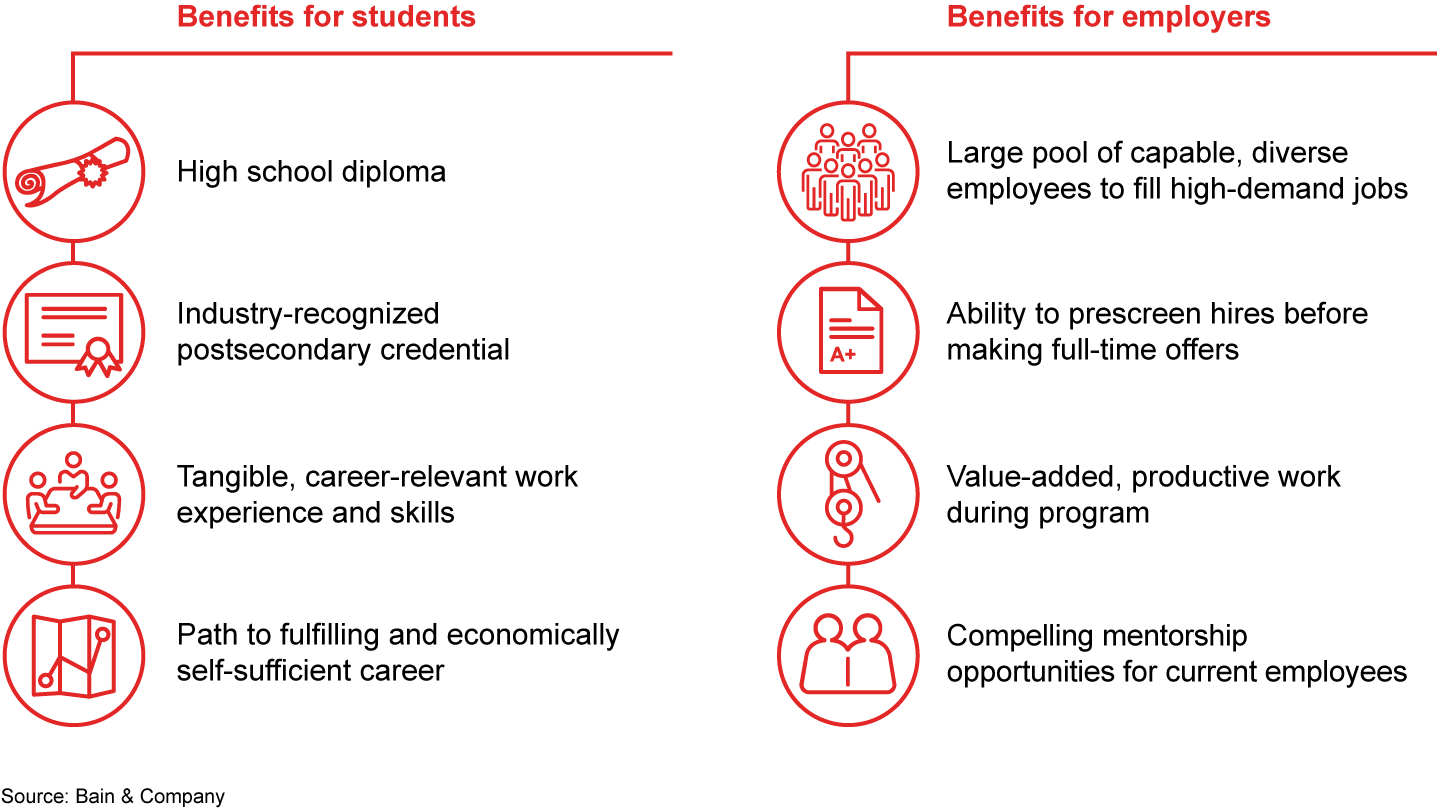
4. It takes a system
When Washington Governor Jay Inslee talks about career-connected learning, he doesn’t hide his ambition: “We are going to stop telling our kids that a four-year degree is the only path to success,” he says of his state’s budding CCL system. “Through registered apprenticeships, technical training programs and other career-connected learning opportunities, we’ll give students all kinds of ways to fulfill their dreams of helping build airplanes, cure diseases or design innovative new software.”
Under Inslee’s leadership, and in partnership with leading employers such as Boeing, Microsoft, Amazon and Kaiser, Washington is pushing forward with an integrated plan to link K–12 and post-secondary schools with employers in a statewide CCL system. Within 10 years, Washington aims to have 60,000 students working and studying in career launch opportunities. Ten years ago, however, such an ambition would have been unrecognizable. That’s when Ben Bagherpour first began thinking about how his Washington company, SEH America, might find enough workers in the Vancouver area to stay competitive. We introduced SEH in chapter 1, when we talked about Nate and his dream of becoming a mechanical engineer. But Nate’s story really began with Bagherpour’s pioneering effort to build a CCL program from scratch.
When Bagherpour got started, few employers or educators were interested in career-connected learning. It took him a decade of painstaking effort to build the relationships and connections he needed to make the program a success. He had to win over the K–12 school system, the local community college, funders and STEM-focused intermediaries. He invited teachers and educators to tour his facility and worked hard to sell them on the value of work-study programs. He helped build a curriculum for a materials science course at the high school and designed an unpaid internship for high school credit. At every turn, Bagherpour struggled to communicate his vision and win critical buy-in. “We were on a rocky road,” Bagherpour recalls. “And we needed to pave the road at every step.”
Bagherpour’s journey highlights both the promise of career-connected learning and the challenges proponents face in trying to make these programs relevant on a larger scale. His persistence paid off with a working model that has helped catalyze the broader effort in Washington, but Bagherpour readily admits that SEH alone has limited impact. It’s providing opportunities to only 40 or 50 a year—a drop in the bucket compared with the number of students who could benefit from the program. For career-connected learning to have real impact, it needs to scale beyond a few small and disconnected initiatives. Providing meaningful opportunity for coming generations means CCL proponents must set their sights on building systemic solutions that make it far easier for new programs to start and for successful ones to recruit more employers and students.
Program rich, system poor
Interest in career-connected learning has been growing in the US and has led to the launch of many successful efforts across the nation. Most CCL efforts today are programs—typically one educational organization working with one or two employers. Some programs are getting terrific outcomes and demonstrating the potential for career-connected learning at greater scale, but few have grown beyond notable to become relevant on a scale that reflects the size of the opportunity. To achieve greater impact, we need to depend less on the heroic acts of a few innovators and create systems with enough critical mass to drive change at a state or regional level.
What do we mean by a CCL system? A system brings together all parties with a stake in career-connected learning to address the opportunity collectively. That means assembling employers, K–12 and postsecondary education providers, state and local government, and intermediaries focused on workforce development (see Figure 4.1). Together, they develop a vision for what the region needs, set an ambition for what they seek to achieve and develop a plan to go after the opportunity. As we’ve previously discussed, CCL systems seek to align all of these actors around a shared vision that is both market driven and student centered. Programs that don’t address real employer needs won’t scale; programs that are built for employers rather than for students won’t create the step change in educational and societal outcomes on which CCL proponents are counting. Getting this right is no small feat.
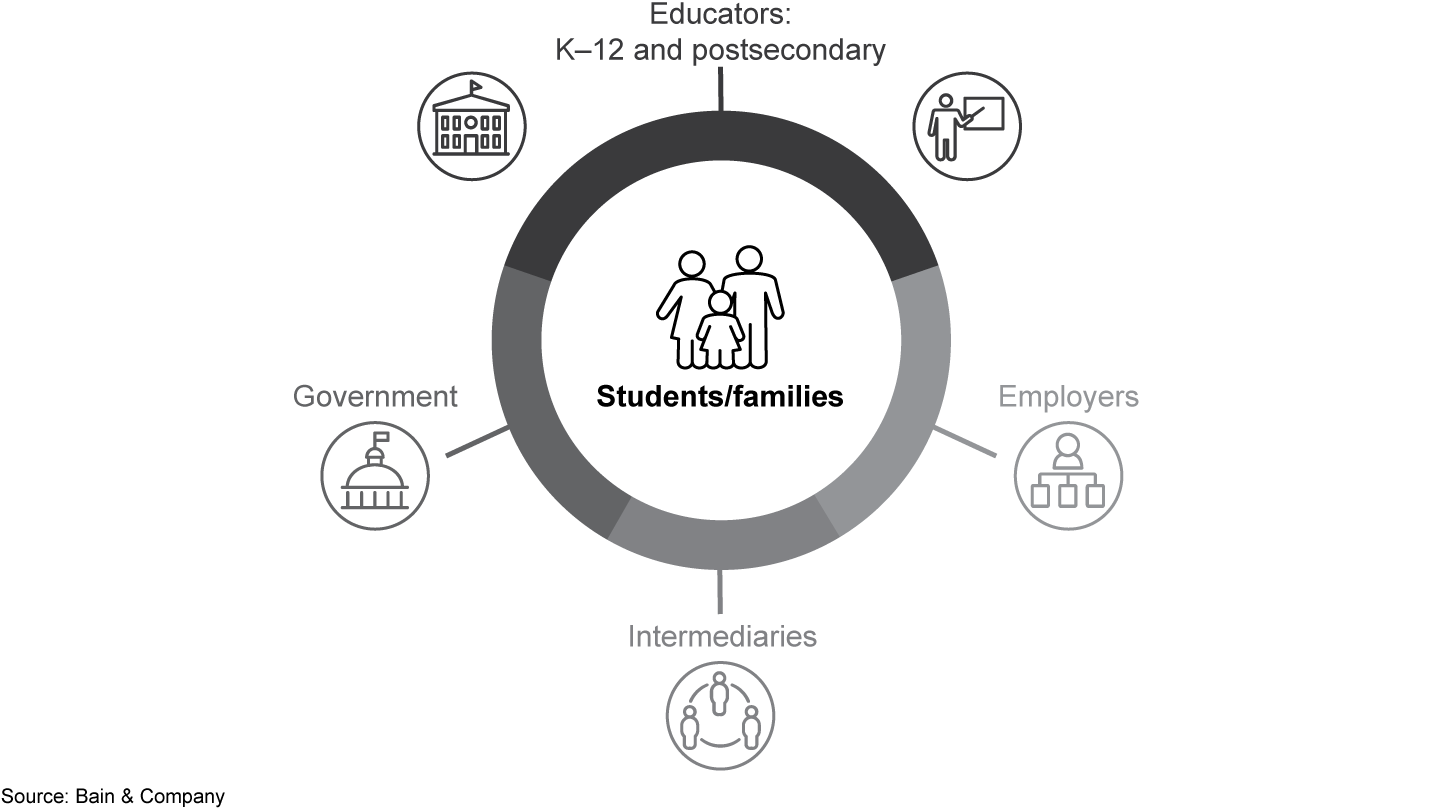
For students, a CCL system needs to deliver a compelling, integrated set of experiences. This begins with awareness programs as early as middle school, extends through preparation programs in high school and culminates with robust career launch programs in the postsecondary years. This last phase should link high-quality on-the-job experience with aligned classroom learning—study and work—in a program that yields a postsecondary degree or an industry-valued credential. It is worth noting that in some places, such as Switzerland and Colorado, this last phase begins at age 16, while students are still in high school. In other places, career launch will begin after high school graduation. What makes these experiences different from the traditional study-then-work four-year academic path is that they fit together and build on each other so that the sum is worth more than the parts.
For employers, a CCL system needs to attract and prepare highly motivated students who will take full advantage of the opportunities provided and succeed in the workplace. Not all students who apprentice will join their employers full time—CCL programs should be designed to enable multiple pathways. But for career-connected learning to scale, it must appeal to companies as an attractive and efficient way to identify and develop talent.
For K–12 school systems and postsecondary education providers, a CCL system needs to be both viable and additive. High schools need to know that these opportunities will increase student engagement, improve high school graduation rates and encourage postsecondary educational attainment—all within existing budgets. Community colleges and the four-year institutions that participate need to know that these programs will boost enrollment and achieve improved educational outcomes consistent with their broader mission.
Career-connected learning at scale
As we’ve noted elsewhere in this report, very large and successful systems that achieve at this level do exist in other parts of the world. Switzerland is the gold standard, but many European countries, including Finland, Denmark, Germany and the Netherlands, have invested in similar systems that serve 50% to 70% of their young adults. Wisconsin and Delaware have built out CCL systems at the state level. And states such as Washington and Colorado are building on these models to design and launch ambitious systems that they hope will help address the opportunities they’re seeing. “What you’re doing through these investments is not only building the workforce of tomorrow, you’re building the middle class of tomorrow,” says former US Labor Secretary Thomas Perez.
The question is, what can we learn from these efforts, and what are the best practices for developing successful CCL systems? Our work suggests it starts with strong leadership—the best statewide systems we’ve seen have been started, or accelerated, by governors. The system also needs a good central organization to manage the complex interdependencies among actors. With that basic structure in place, a successful system must do four critical things well (see Figure 4.2).
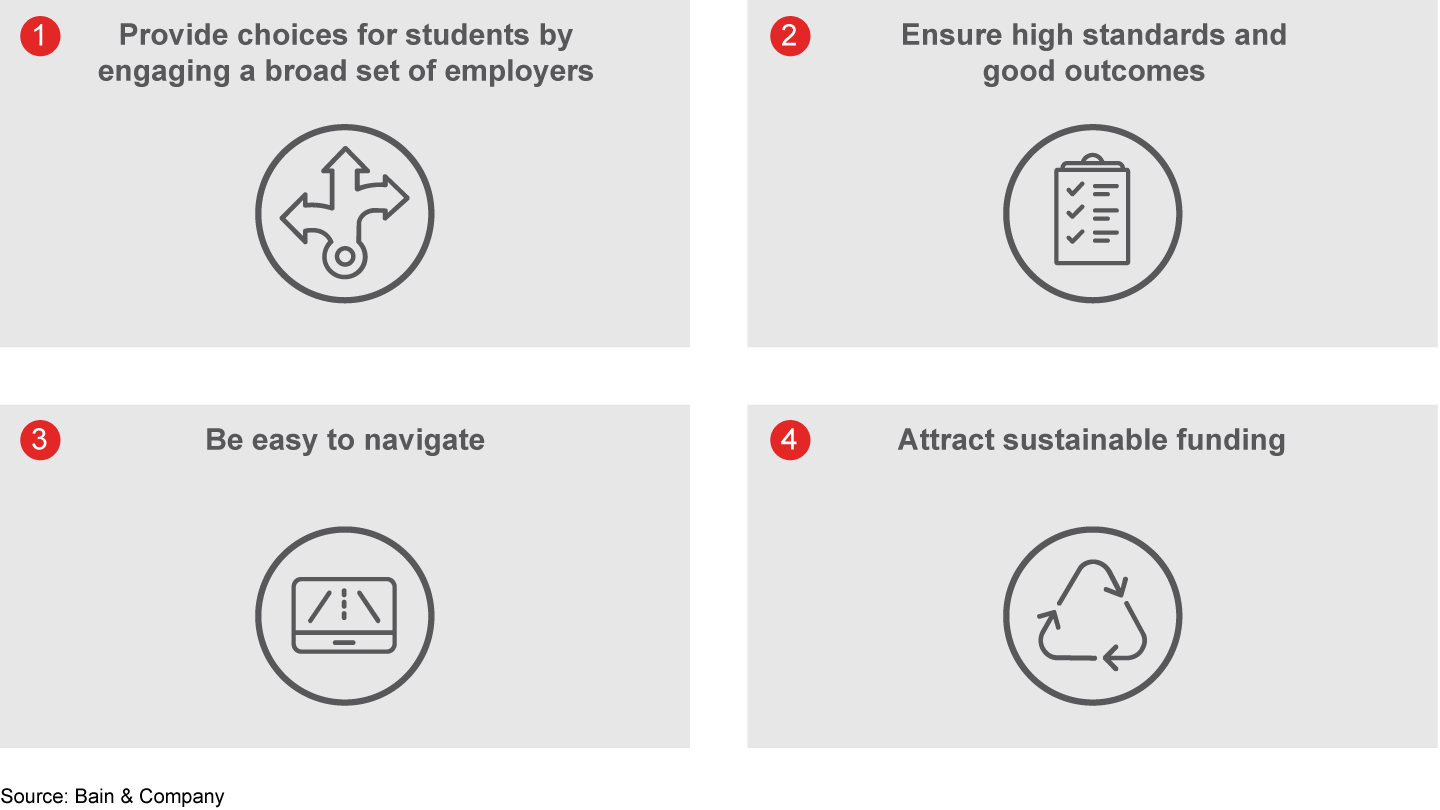
Provide choices for students by engaging a broad set of employers
First, CCL systems need to provide a variety of choices for students and address the needs of a broad set of employers in the region. We can’t assume that everyone wants a job in information technology or a job in advanced manufacturing just because those are the largest employers in town. We need to enlist multiple employers across multiple industries to build pathways toward a variety of good job opportunities. In Switzerland, which has been at this for decades, students have a choice of 230 occupations. Colorado has focused on five main career pathways—advanced manufacturing, information technology, financial services, business operations and healthcare—each of which contains multiple subcategories. Wisconsin has 11 career clusters containing 49 career pathways. In these systems, students have choices, and those choices focus on good jobs and compelling career pathways.
Ensure high standards and good outcomes
Second, systems need to ensure high standards and good outcomes. One reason it is challenging to scale career-connected learning is that traditional vocational programs often suffer from a second-class stigma. Growth and sustainability depend on raising the bar so that students and families believe that these new pathways are attractive and viable—that they are high quality, rigorous, and will lead to both good jobs and an opportunity for ongoing education. Educators also need to believe in the CCL mission and that the programs they are being asked to create rise to a high standard. At the same time, employers need to know that the programs are meeting real business needs and are competitive with other sources of talent.
Pulling all this off requires both a firm commitment to quality and the ability to negotiate trade-offs between different interests. In Colorado, CareerWise tightly manages all its youth apprenticeships. It chooses the pathways, which educational programs schools will offer and what requirements students must meet to apply. Within the chosen education programs, CareerWise works hard to ensure that schools recognize and reward work-based experience. It is important that the credits earned are both transferable and stackable, meaning they build toward credentials, which gives students the confidence that future educational opportunities are still open to them. To help attract more employers looking for the best talent, the system has also sought to ensure that there are more student candidates for each apprenticeship than there are offerings—something that has been very hard for educators to accept. In Washington, the focus on quality means that leaders have spent a great deal of energy codifying what will and won’t qualify as a career launch program. To provide a common imprimatur for these programs, leaders have considered creating a new certification that could be bestowed on (or withheld from) a program in recognition of hitting a predetermined career launch standard. Having an independent body own that designation would as-sure employers, educators and families that they are signing up for something that will work. But this idea has met with opposition. Existing programs do not generally want to be judged by new standards. The existing educational institutions that currently own credentialing powers do not welcome the idea of an outside body providing or withholding an additional stamp of approval. Fighting and winning these types of political battles is a key role of CCL systems.
Be easy to navigate
Third, CCL systems must be easy to navigate. We cannot expect large numbers of employers to participate in a system that forces them to jump through hoops and wade through red tape. Thus the need for intermediaries—namely, organizations that provide the connective tissue within the CCL system and work on behalf of stakeholders to bring the idea to life. Intermediaries do the work of convening employers. They identify good jobs that are in high demand, help define shared pain points within talent pipelines, and codify the skills and competencies that successful employees will need in a given role. They also work with educational institutions to design programs that will develop those skills and competencies. What’s critical is that they have a deep understanding of both the employer and educator realities. In Switzerland, trade associations and professional organizations play a key role in designing the educational programs (both work experience and classroom learning) that make up an apprenticeship. In Colorado, CareerWise is the single statewide intermediary playing this role across multiple industries. In Washington, a mix of industry associations, labor unions and regional nonprofit networks likely will fill the role, depending on region and industry.
Attract sustainable funding
Last, but certainly not least, CCL systems must attract sustainable funding. Career-connected learning requires investments from students (time and money), employers and education providers alike. Success depends upon providing real benefits to employers, attractive pathways to students and educational models that can work at maturity within the bounds of available student funding.
Employers not only need to devote time and energy to awareness and preparation efforts, such as career fairs and internships, but they also need to devote real resources toward designing and offering meaningful work-based learning opportunities. Paying students for their work is only part of it. To operate at scale, the most effective employers staff up internally to manage the program, dedicate supervisor and mentorship time, and often reimburse tuition required for classroom work. As we noted in chapter 3, successful systems, such as the one in Switzerland, make it a priority to build ROI considerations into their programs. And employers who have committed to early efforts in the US are seeing their investments pay off. Officials at Pinnacol, the Denver-based workers’ compensation insurer, say they have made a sizable investment to bring on 20 apprentices. But the company is carefully tracking the program’s ROI and making sure students are doing real work that adds value. Longer term, explains Julie Wilmes, Pinnacol’s apprenticeship program lead, the company is counting on the program to become an important talent-acquisition strategy. “If that happens—and we expect it to—this becomes a very worthwhile investment for us,” Wilmes said.
For educators, of course, realigning resources is disruptive and makes for difficult conversations. Consider what happens when more students take college-level courses during high school. This requires schools to change their staffing structure significantly by either finding and employing a higher number of teachers who are certified to teach college-level courses or by sending more of their students to the local community college to take classes there. This can be achieved with flexible schedules, but the more difficult trade-off comes when a significant portion of students are no longer on a high school campus, which ultimately leads to fewer teachers.
A similar dynamic can require negotiation at the postsecondary level. A typical associate’s degree requires 60 semester credits, all earned in the classroom. But in a CCL program, a significant number of those credits are earned in the workplace. While the postsecondary institution may certify the learning that is happening in the workplace, it is not earning full tuition for those credits. Seen this way, career-connected learning can be interpreted as a threat to the higher education revenue model.
Those who have made progress on these issues advise focusing on early wins and utilizing philanthropy to get the flywheel spinning. As former Denver Public Schools Superintendent Tom Boasberg says, “Start small, start in pilots, and start with the willing.” Once a system can demonstrate success, it becomes a lot easier to sell the concept more widely. The good news is that the philanthropic community is currently showing great interest in career-connected learning. Bloomberg Philanthropies, the JPMorgan Chase Foundation, Siemens Foundation and the Bill & Melinda Gates Foundation are just a few of the big-name philanthropies putting money toward these efforts. At the same time, CCL proponents have to go in with their eyes open. Nonprofit funding can be invaluable for building pilots and paying for specific programs, but in most cases, it won’t rise to the level of support a system needs to thrive and scale long term. That means many states will have to find ways to redirect funding away from lower-impact programs and toward CCL efforts.
Making it happen
None of this is easy. But it is getting done, and some very impressive efforts are starting to find their wings. During our research and experience in the field, we’ve learned some common lessons from the most successful CCL systems.
Governors are key. Strong executive leadership is an essential ingredient for building a successful statewide CCL system. Washington Gov. Inslee and outgoing Colorado Gov. Hickenlooper have both become strong CCL proponents and have given these efforts high visibility in their respective states. Colorado and Washington both have a lot to gain from career-connected learning. Around 70% of jobs in those states require postsecondary education, yet 40% or fewer of the young people in either place are attaining postsecondary credentials. That’s why both governors led sizable delegations of business leaders, educators and philanthropists to Switzerland to learn about the thriving CCL model in that country. Both put real political capital behind the idea of creating not just more CCL programs but a true statewide CCL system. That is paying off in real interest and commitment among both educators and important figures in the business community. In Washington, for instance, the Career Connect Business Leadership Committee includes Brad Smith, president of Microsoft; Ray Connor, chairman of Boeing; and Susan Mullaney, president of Kaiser Permanente Washington—among many others.
But governors can’t do it alone. A strong system needs a central statewide organization specifically devoted to career-connected learning. That requires assigning a dynamic leader—someone who wakes up every day focused on building a great CCL system. This organization is ultimately responsible for drawing together key actors and making sure the complex interdependencies between them are being managed. It must enforce quality control and coordinate innovation and learning. It manages communication statewide and assumes accountability for the effort’s success. To do this well, the central CCL organization needs to work effectively across business, education and government stakeholders. That requires an independent agency with enough authority to exert influence over this web of interdependent actors. Both Denver’s CareerWise and Washington’s Career Connect Washington, for instance, exist outside state government, education and the business community.
It takes a village. CCL systems are a massive endeavor, and they require strong cross-sector commitment. They need forceful representation from the business community, key leaders in education, the government and influential intermediaries. In Colorado, a relatively small group of business and education leaders were involved in the original design. In Washington, the stakeholder group has been far more expansive. There are advantages and disadvantages to both approaches. Colorado moved quickly and nimbly to start a pilot program but will have to enlist more stakeholders as it scales into a statewide system. The Career Connect Washington team has chosen to engage up front with more than 3,000 constituents statewide, an effort that has generated more than 12,000 travel miles among leadership. This commitment to early engagement has made for slower going but has helped Washington leadership build a large support base from the beginning.
Whichever engagement model the system adopts, it is critical that stakeholders have a voice in defining the system’s vision and aspiration. Every word of the Washington system’s vision statement, for instance, was vigorously debated, and all of the eventual participants in the system were given a chance to voice their input. In the end, the statement was relatively succinct and served as a compass for further action: “Every young adult in Washington will have multiple pathways toward economic self-sufficiency and fulfillment, strengthened by a comprehensive statewide system for career-connected learning.”
It is also essential to establish roles and responsibilities early. For a system to work smoothly, all the key players need to know who is doing what and when. At the highest level, educators need to hammer out how their career-oriented classroom learning opportunities will align with on-the-job work experiences. Employers need to invest in the development of prospective employees. Intermediaries need to build bridges between educators, employers and students. Governments need to ensure that policy and funding support both growth and excellence (see Figure 4.3).

While this may appear straightforward, enormous tensions can lurk beneath the surface. Generally speaking, educators resist the idea of delivering employees rather than students, employers would like programs designed and tailored for their unique needs, intermediaries want to run their own programs in isolation, and governments generally are not set up to absorb and respond to what amounts to a paradigm shift. The way past these obstacles begins with establishing clear roles and governance, including well-defined decision rights. But the essential glue that holds it all together has to be a shared commitment to a higher purpose. Every stakeholder has to believe that as hard as it is to build a CCL system, it is our best chance to create real opportunity for young people from all walks of life.
We’re in this together. CCL systems require shared accountability. In Colorado, CareerWise committed to serving 20,000 students within 10 years. That, in turn, inspired Denver Public Schools not only to build a small pilot but also to think carefully about scaling. Denver Public Schools aims to have 2,500 juniors and seniors participating within five years. These large commitments inspired action and helped push difficult decisions forward.
Washington, likewise, has thrown out some audacious goals. Within 10 years, the state pledges to have career awareness and preparation experiences available to 100% of students and wants 60% (or 60,000 students) participating in career launch programs. The act of articulating these goals opens up conversations with key players on how they will contribute and to what they will commit. Getting firm commitments from employers is hard. Most would rather develop a small program on the side, within their corporate social responsibility budget, rather than risk devoting meaningful resources to an unproven system.
The key is to recruit the employers out there who are willing to serve as leaders and champions. Pinnacol in Colorado and Kaiser and Avista in Washington are examples of employers that went with governors on trips to Switzerland, saw what was possible and came home committed to building a system. Kaiser, for instance, saw career-connected learning as a critical way to fill an acute need for more medical assistants and pharmacy technicians. Rather than build a program tailored to its specific needs, the company committed to convening all its peers, along with labor and education, to create an industrywide apprenticeship that the group plans to launch in January. Scott Morris, the chief executive of Avista, an energy utility in Spokane, was also a quick convert after seeing how powerful career-connected learning is in Switzerland. Avista has started building a CCL program for local students and is committed to being an anchor within the statewide system. “As an employer you can do this. You really can do this,” Morris said at a CCL event in Washington. “Within six months, we built a team, we put together 18 students at our company, they had an experience for four weeks, where they got a credit. … Our approach was ‘how might we,’ there wasn’t any ‘why can’t we.’”
Getting started: Developing a CCL system
In the world’s most competitive economy, it simply makes no sense that a majority of the young people who enter high school won’t earn a postsecondary degree. It’s absurd that so many walk into the working world unprepared to start a meaningful career. We can do better. What’s encouraging is that in communities across the US, career-connected learning is rapidly gaining momentum. The success of innovative programs—often between a single forward-thinking employer and an innovative educational institution—is stirring real interest among state officials, business leaders and educators in building scale CCL systems. The need is great. The excitement is real. The question is, how do we get started?
Based on our research and hands-on work with several statewide CCL efforts, here are some important ways to start building momentum.
If you are a governor:
- Convene the appropriate business leaders—those with the most good jobs and the greatest need—and provide a forum in which their voices can be heard and their support enlisted
- Be the sponsor within government and education, and fight for the changes that need to happen
- Advocate for a market-driven, student-centered approach
- Set up and empower an organization to convene the key stakeholders, articulate a shared ambition and begin the work of bringing a CCL system to life
If you are a business leader:
- Recruit your peers
- Pound the table for a collective systemic effort
- Put your money where your need is—launch, support and help scale promising programs that can serve as proof points
If you are a K–12 education leader:
- Engage with business leaders and leaders in higher education to cocreate programs
- Communicate with students and families about study-and-work career paths, not just the traditional study-then-work route to a four-year college
- Design career-connected learning as an attractive option for all students, with a broad range of academic abilities and interests
If you are a higher education leader:
- Engage with business leaders and leaders in the K–12 system to cocreate programs
- Recognize (and trumpet) that career-related outcomes are valuable, as is academic achievement
- Value and reward learning that happens through work as well as in the classroom
If you are a philanthropist:
- Fund the convening of a committed group of leaders across the business community, K–12 and higher education
- Push for the development of a scale system, with collective action across multiple employers and educational institutions
- Insist on eventual financial sustainability.
About Bain's Education practice
Bain & Company is committed to supporting high-impact organizations looking to transform education around the world. We work with institutions of all types—including school districts, charter schools, community colleges, organizations focused on supporting students with in-school and after-school services, educational technology providers and education-reform organizations focused on human capital.
Bain partners with these organizations to develop strategies and business plans, improve performance, structure the organization for success, and attract and retain talent, working alongside our clients toward the shared goal of accelerating student achievement.
Our work has highlighted what we believe is one of the most critical needs facing education in the US today: career-connected learning. Our work with organizations across K–12 and higher education, our broader private sector work with employers, and our expertise in human capital strategies helped to highlight key challenges and potential solutions for designing and scaling high-quality CCL programs.
The authors
Chris Bierly is a Bain partner based in Boston. He leads Bain’s Global K–12 Education practice. He has more than 30 years of management consulting experience, advising clients across the private, public and nonprofit sectors.
Abigail Smith is a Bain partner based in San Francisco. She is a core leader of Bain’s K–12 Education practice, serving education clients globally. Prior to Bain, she was a high school math teacher at a large urban public school.
For comments or questions on our report, contact us at CareerConnectedLearning@Bain.com.
Acknowledgments
We would like to recognize and thank the Bain team who conducted this research effort: Charlotte Biffar, Jessica Bixby, Christine Brogan, Janna Bubley, Abraham Jenson, Thomas Lee, Varin Neitzel and Gigi Nunes. We’d particularly like to thank the Bain CCL teams, led by Anna Cocheme, Anna Geyler, Nafi Israel and Jeff Fortner, from whom we learned so much.
We deeply thank Maud Daudon and Marc Casale in Washington, Tom Boasberg and Gretchen Morgan in Colorado, and Jon Schnur and the team at America Achieves for their counsel and thought partnership.
We further acknowledge Ben Bagherpour and Natalie Pacholl at SEH America, Ardine Williams at Amazon, Scott Morris at Avista, Susan Mullaney and Kim Sullivan at Kaiser Permanente Washington, Ray Conner at Boeing, Suzi and Eric LeVine for their systems building work in both Colorado and Washington, and the many other leaders who shared their experiences with us.
We benefited greatly from the scholarship and thinking coming out of New America, led by Brent Parton; the Pathways to Prosperity Network; The Good Jobs Project, a research project led by The Georgetown Center and JPMorgan Chase; and the Good Jobs Institute.
Finally, we extend our deep gratitude to Michael Oneal for his fortitude and perseverance in seeing this project to completion.






















